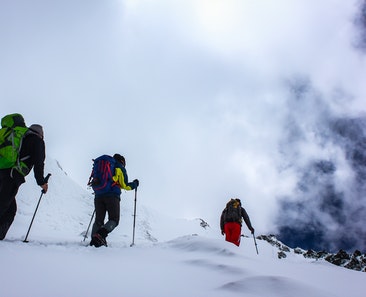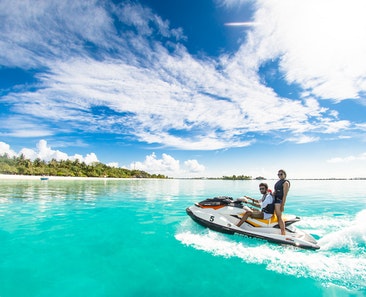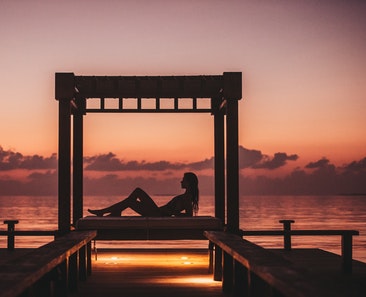Bhutan Trekking: The Druk Path Trek and New Trans Bhutan Trail
Last Updated on August 6, 2022 by Audrey Scott
What is it like to go trekking in Bhutan? To go on a Himalayan mountain adventure with wide open landscapes, snow-covered peaks, Buddhist temples, prayer flags, high altitude camping and alpine lakes? We share a taste of trekking in Bhutan with our Druk Path Trek experience — including what you’ll experience day by day, difficulty, how to pack and organize a Bhutan trek, what to expect from a winter trek, and why this is one of the most popular treks in Bhutan. We also share information about the Trans Bhutan Trail, a new hiking route in Bhutan coming available in 2022.
Over the last years we've been fortunate to do some incredibly beautiful and challenging hikes around the world, yet hiking in Bhutan remained high on our travel wish list. We were curious about the trekking experience given the country's location in the Himalayas, its focus on environmental conservation and the fact that Bhutan sees so few visitors.
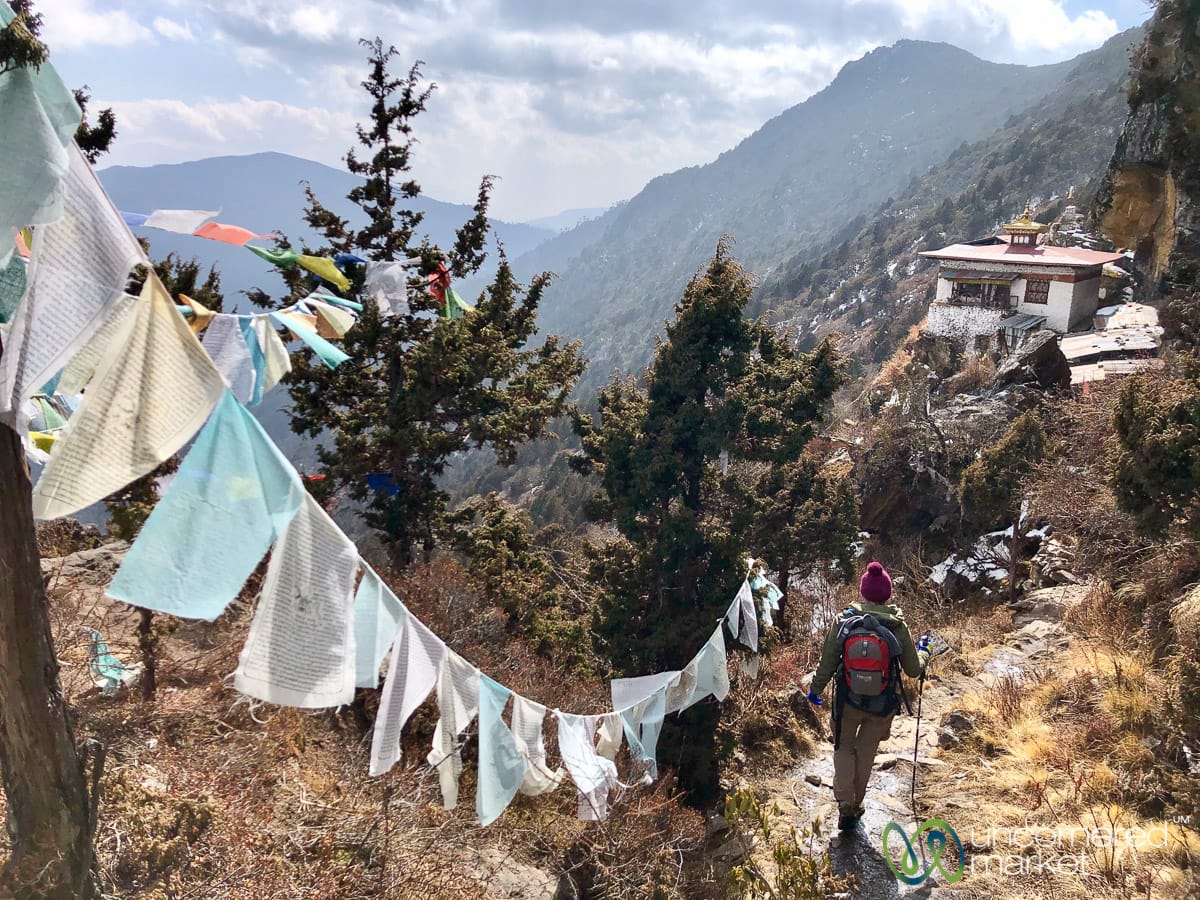
We chose to hike the Druk Path Trek, one of Bhutan's most popular trekking routes, in late January-early February. Our decision to do a winter trek, something that we had never done before (we usually flee the cold), provided a new sort of adventure, experience and challenge for us.
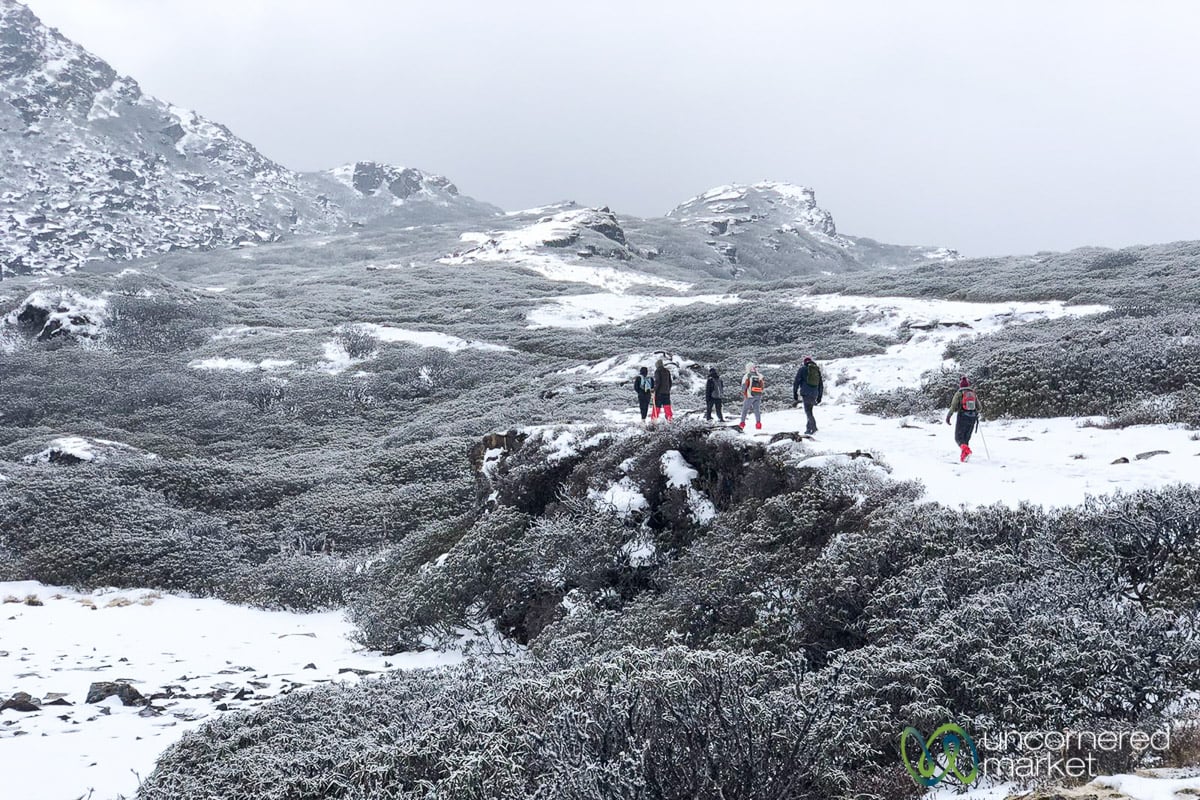
The experience did not disappoint. We enjoyed the winter trekking experience, appreciating the snow, stillness and silence. The following tells why — and makes the case as to why you might want to add trekking in Bhutan, whether the Druk Path Trek or another route, to your trekking wish list.
We’ve included in this Bhutan Trekking Guide all you need to know to plan, prepare for and enjoy trekking in Bhutan. In addition, we provide some information about a new trekking route in Bhutan – The Trans Bhutan Trail — recently restored and opening up again to the public in April 2022 for the first time in 60 years.
The following experiences are from our Druk Path Trek on a tour to Bhutan with G Adventures. Currently, this tour no longer includes the Druk Path Trek as part of its itinerary, but if you want to go trekking in Bhutan then we recommend looking into the G Adventures Camp the Trans Bhutan Trail (11 days) or Highlights of the Trans Bhutan Trail (12 days). If you want to know what to expect on a trek in Bhutan, this article shares a taste of a trekking itinerary and route, trek difficulty, campsites, food, and what you need to pack and prepare. Disclosure: This tour was sponsored and provided to us in conjunction with our partnership with G Adventures as Wanderers.
Bhutan Covid Travel Requirements
Bhutan is opening up to all tourists on 23 September, 2022 without any quarantine requirements (check for official updates). Bhutan used its focus on community and trusted leadership to manage the pandemic quite well. In April 2021, Bhutan was able to vaccinate 85% of adults (first shot) in just one week and in early 2022 the country was finishing up a booster vaccination campaign. This shows the country's commitment to public health and protecting its people.
Find more Covid-19 travel resources and recommendations on how to travel responsibly during Covid with care towards the health and safety of local communities and people.
The Trans Bhutan Trail: A New Trekking Route in Bhutan Starting in 2022
The history of the Trans Bhutan Trail is deep and goes back thousands of years as an ancient trading and pilgrimage routes between Bhutan and Tibet. The trail not only connected fortresses, or Dzongs, across remote areas of the Bhutanese Kingdom, but it was also used by Buddhist pilgrims to visit sacred sites and temples in western Bhutan and Tibet.
Although the trail was actively used for centuries as it was the only way to get to certain remote parts of the country, it fell into disrepair and disuse in the 1960s. Repair of the trail began in 2018, but the restoration of the Trans Bhutan Trail was accelerated during the Covid-19 pandemic as 900 furloughed workers worked to rebuild bridges and create hundreds of miles of footpaths.
The Trans Bhutan Trail is being opened to the public in April 2022 so travelers, local people and pilgrims can walk this ancient trail once again. The total length of the Trans Bhutan Trail is 403km / 250 miles long, going from Haa in the west to Trashigang in the east. Don't feel like you have to do it all; you can select shorter segments of the trail to experiences specific mountain landscapes and culture.
The goal of hiking the Trans Bhutan Trail is not only to be able to enjoy the stunning landscapes and nature of the high Himalayan mountains, but also to connect with local people, culture and communities along the way through village homestays, sourcing food from local farms, and other community initiatives so that rural communities also benefit from the trail and tourism.
In addition, the Trans Bhutan Trail is focused on several sustainability initiatives to conserve the natural environment, from a zero plastics policy along the trail (which also includes providing refillable water bottles and filtered water) to planting a tree for each international visitor.
Our partner, G Adventures, was selected as the first group adventure tour operator to offer trekking tours when the trail opens in 2022. This speaks to the alignment of values regarding community tourism and sustainability.
Currently, G Adventures is offering two different active tours that include selected segments of the Trans Bhutan Trail. This includes the G Adventures Camp the Trans Bhutan Trail (11 days) that has a similar style as the tour that we took as it includes four days of trekking with several nights of camping. Alternatively, Highlights of the Trans Bhutan Trail (12 days) also includes several days of hiking the Trans Bhutan Trail, but has more family homestays and guesthouses for overnights than camping. Both tours include both trekking and visiting some of Bhutan's famous monasteries, temples and sites, so it's a good balance of experiences and immersion into Bhutan's nature, culture, history and cuisine.
What to Expect on a Bhutan Trek: The Druk Path, Day by Day
The Druk Path Trek, or Thunder Dragon Path, takes you approximately 36-45 km (22-28 miles) through pine forests and rhododendron thickets, along mountain ridges and past alpine lakes in the lower Himalayan Mountains in western Bhutan. The trail follows an ancient mule route connecting Paro and Thimphu, and the area plays home to yak herders in the summer months. The highest point of the trek is Labana Pass at 4,200 meters / 13,800 feet. Much of the trail and its campsites sit at a similar and fairly high altitude, so the Druk Path Trek is considered a medium-difficulty trek.
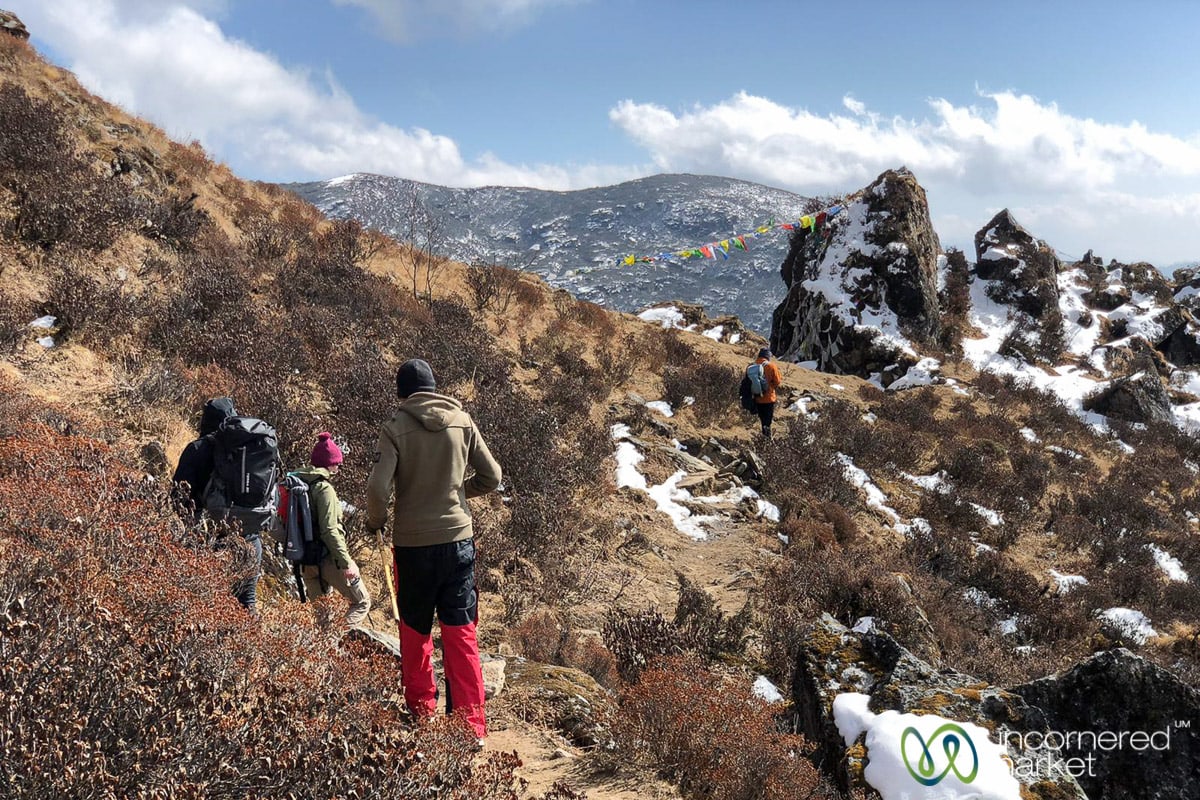
When I researched the Druk Path Trek, especially for information regarding winter trekking and conditions I found plenty of tour itineraries. However, I didn't find many details or images of the different landscapes and experiences — and possible weather — along the trek.
That's what this “Day by Day” section is aimed to do: to help you understand the actual trek journey and give you a sense of what you might encounter and experience each day, including the camping, difficulty of the trail and landscapes.
Our days usually began early, with tea served to us inside our tents around 6:30 A.M. Breakfast followed around 7:00. The goal was to set off on the trail in the morning when the skies were still clear and the sun had the chance to warm things up. As is typical in the Himalayas, clouds might develop as the morning and day unfolded.
Note: The route below is for the four-day Druk Path Trek that we took with G Adventures in late January. Many tour companies offer this as a five to six day trek, but we found that four days was perfect for us in terms of the daily distance, difficulty, breaks and free time in the evenings at the campsite. If you are in reasonable shape and have some experience trekking at altitude then four days for this trek should provide ample time.
Our trekking guide made a couple of adjustments to our route due to winter conditions so that the mules carrying our gear wouldn't injure themselves on the snow and ice. If you do the Druk Path Trek in the spring or fall you might notice a few differences to the route below, but most of it will be the same. Also, our guide said that our small group walked rather quickly. Some daily hiking times might be longer if your group is larger or has less experienced trekkers. Note: the hiking times below do not include resting, snack and lunch breaks.
Day 1: Ta Dzong to Jele Dzong Temple to Tshokam
Most Druk Path Treks set off from outside Paro in the early morning. You'll make your way by van transfer along a relatively new dirt road rising into the hills for around 30-45 minutes. (Prior to the road being built, this segment was part of the actual trek.).
At the conclusion of this short ride, you'll meet your trekking support team: a cook, assistants, mule handlers and a group of mules to carry your tents, your allotted camping and trekking gear, all the food and cooking gas, and the kitchen, dining and bathroom tents.
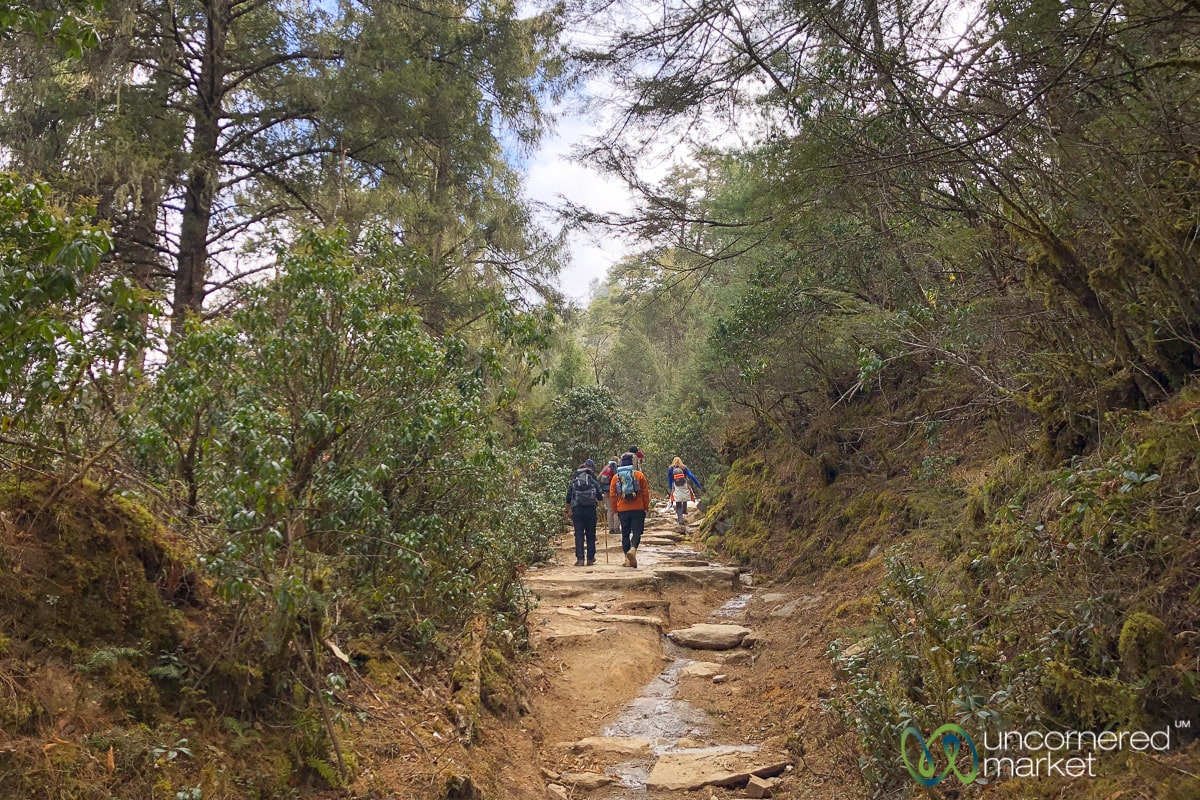
The start of the walk begins on the dirt track and eases you into things with a slow and steady incline that takes you into mid-alpine woods. Eventually this turns into a steep uphill for around 45 minutes through beautiful forest trails until you reach a clearing where you begin to get above nearby hills and have a view of the valley below.
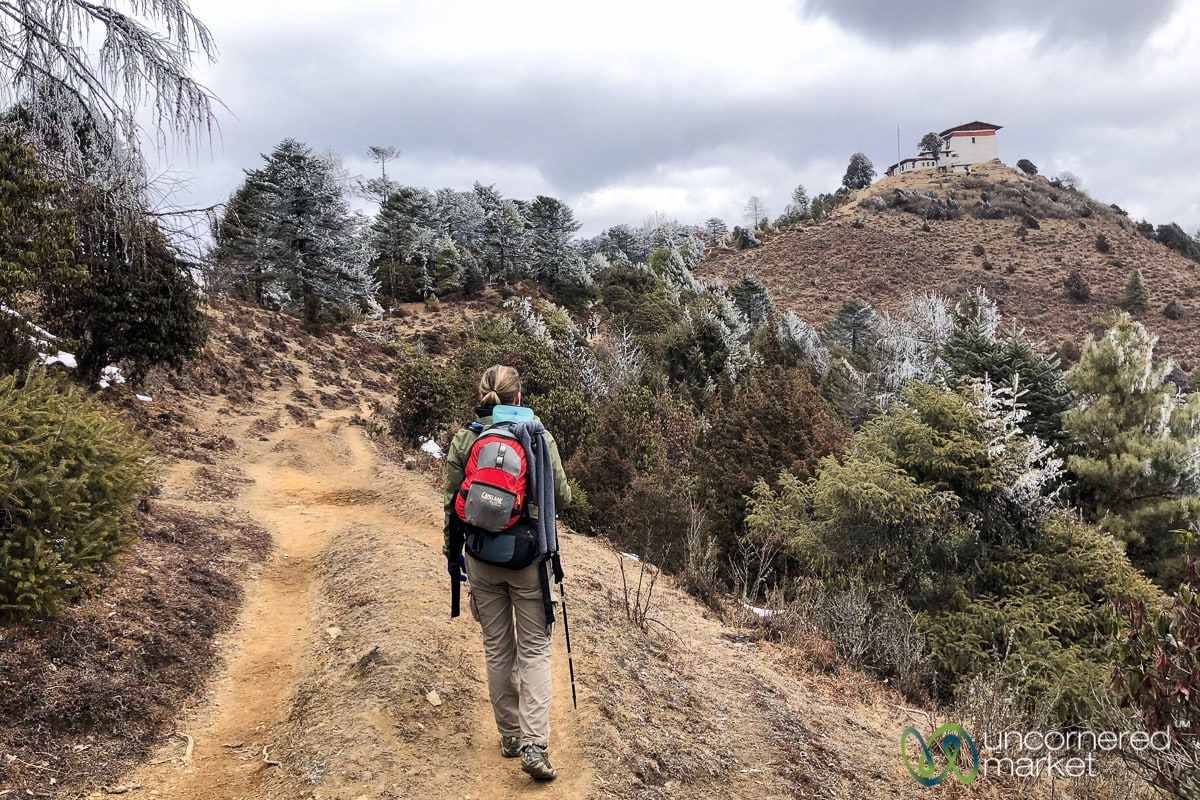
After a short incline you'll reach the 15th century Jele Dzong temple and take a tea break. The temple guardian was away during the time of our visit. If he's around, you'll be allowed to explore inside.
We continued onward alternating between forest paths and trails along the edge, revealing valley views and mountain layers in turns. At one of the clearings we stopped for lunch, a hearty meal of rice and several hot dishes.
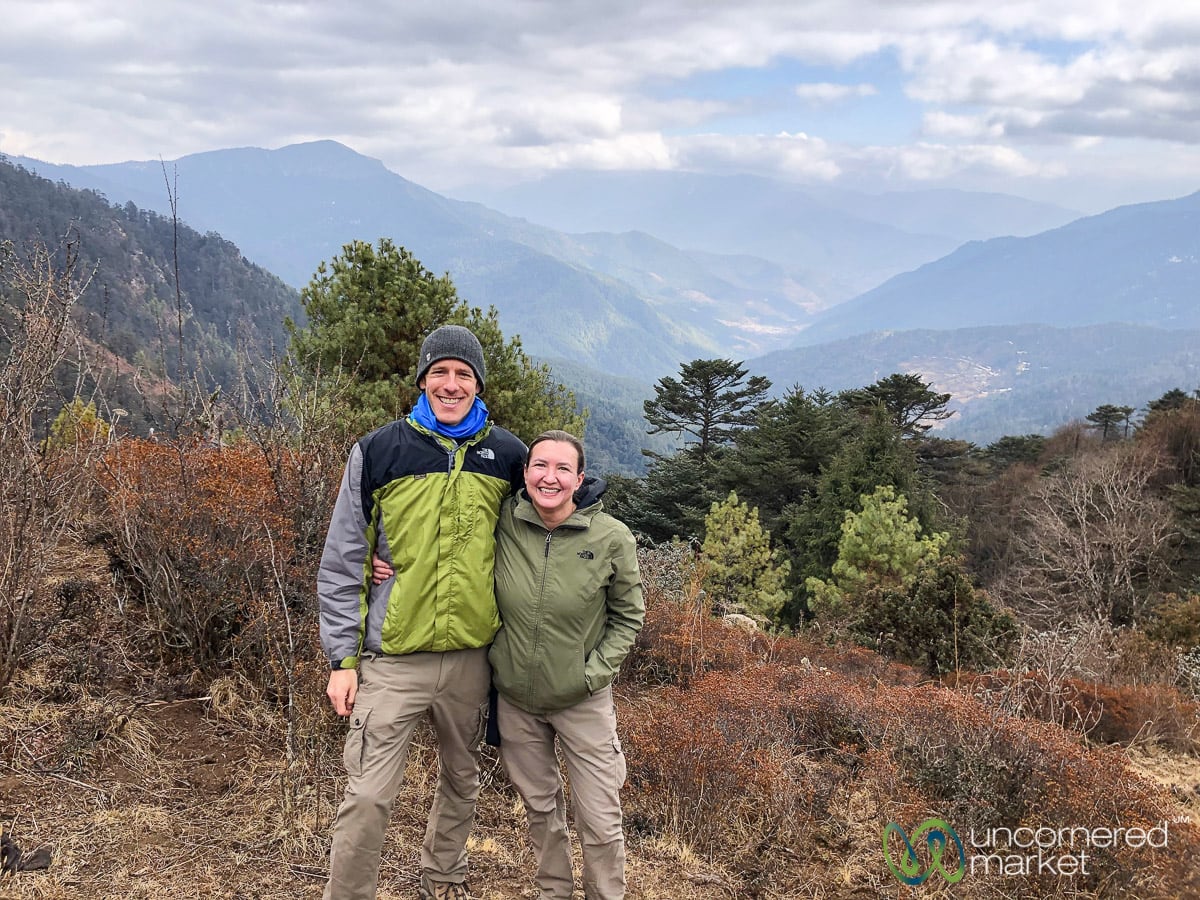
We began our final push towards the Tshokam (Dry Lake) campsite (3,800 meters/12,500 feet) on mostly flat trail. When we arrived, our tents had already been set up for us, which is always nice to see after a day of hiking.
We took the free time and enjoyed the last bit of sunshine with some snacks and tea outside. It gets cold once the sun sets, so we enjoyed a bonfire before and after dinner.
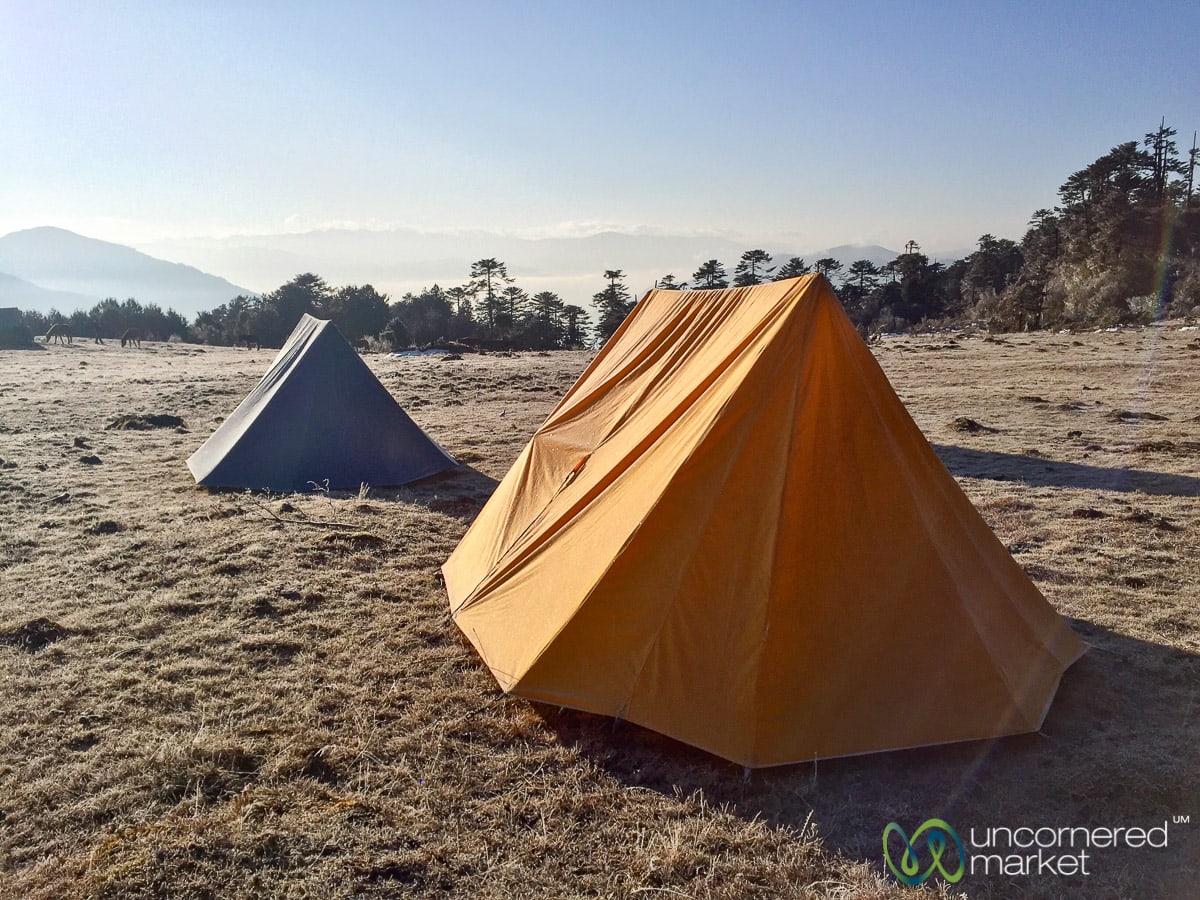
Day 2: Tshokam to Janytscho to Simkotra Lake
While this is a shorter trekking day than the first, it features a couple long, steep inclines which make for a bit of a challenge. Our guide had to make a few adjustments on this day due to snow and ice on the trail. As a result, we didn't go on the higher (and longer) trail to Jimilang Tsho lake as it was dangerous for the mules.
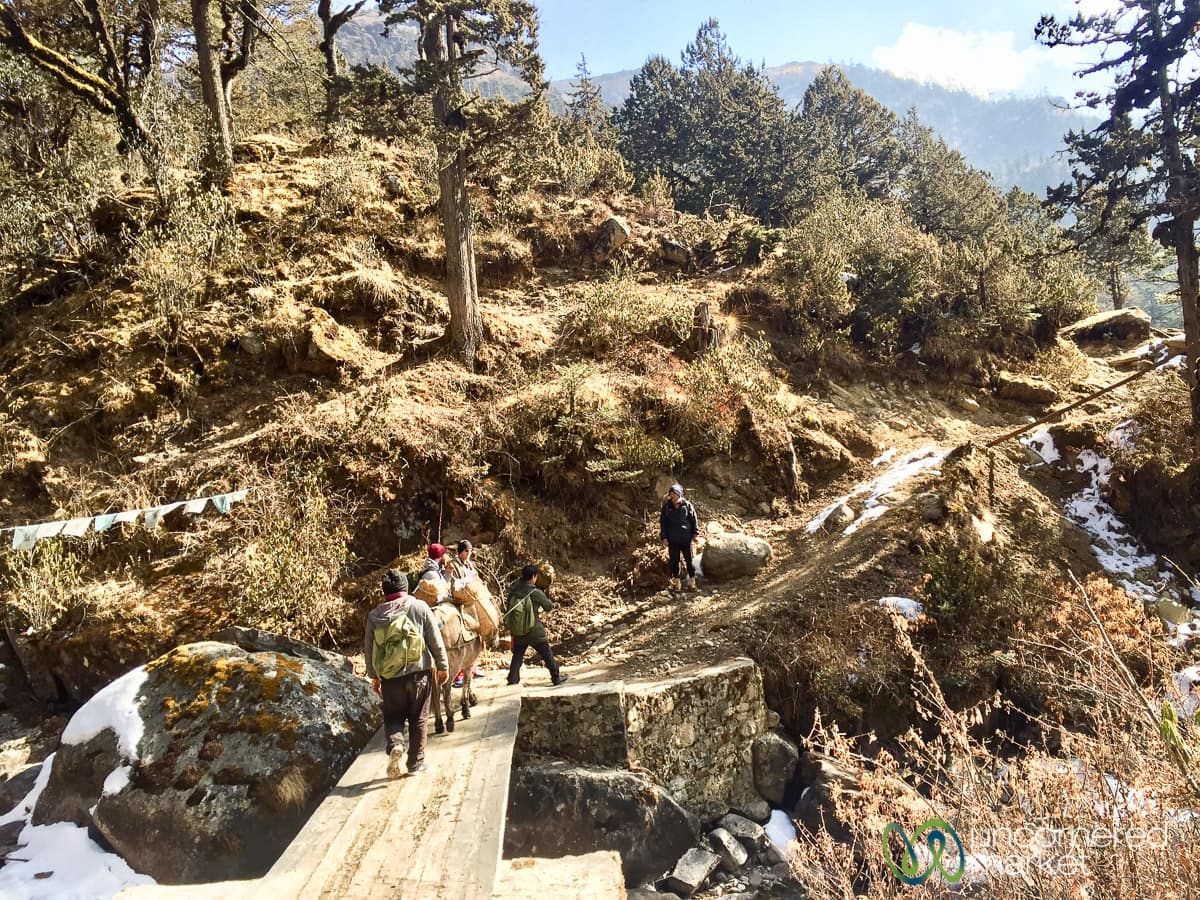
The first segment of the day is relatively flat and takes you on a forest trail along a stream and over a bridge. After a short break there, you continue to a clearing called Narithang for some mid-morning tea and snacks.
Then the uphill really begins. This was a steady climb of a couple of hours through the forest. The idea: go slow and steady on the steep incline so that you maintain a consistent pace as you climb in altitude. The trail continues from the woods onto a clearing at Janytscho which overlooks the lake. This is where we stopped for lunch and a rest, but we've heard that some groups will stop here to camp for the night.
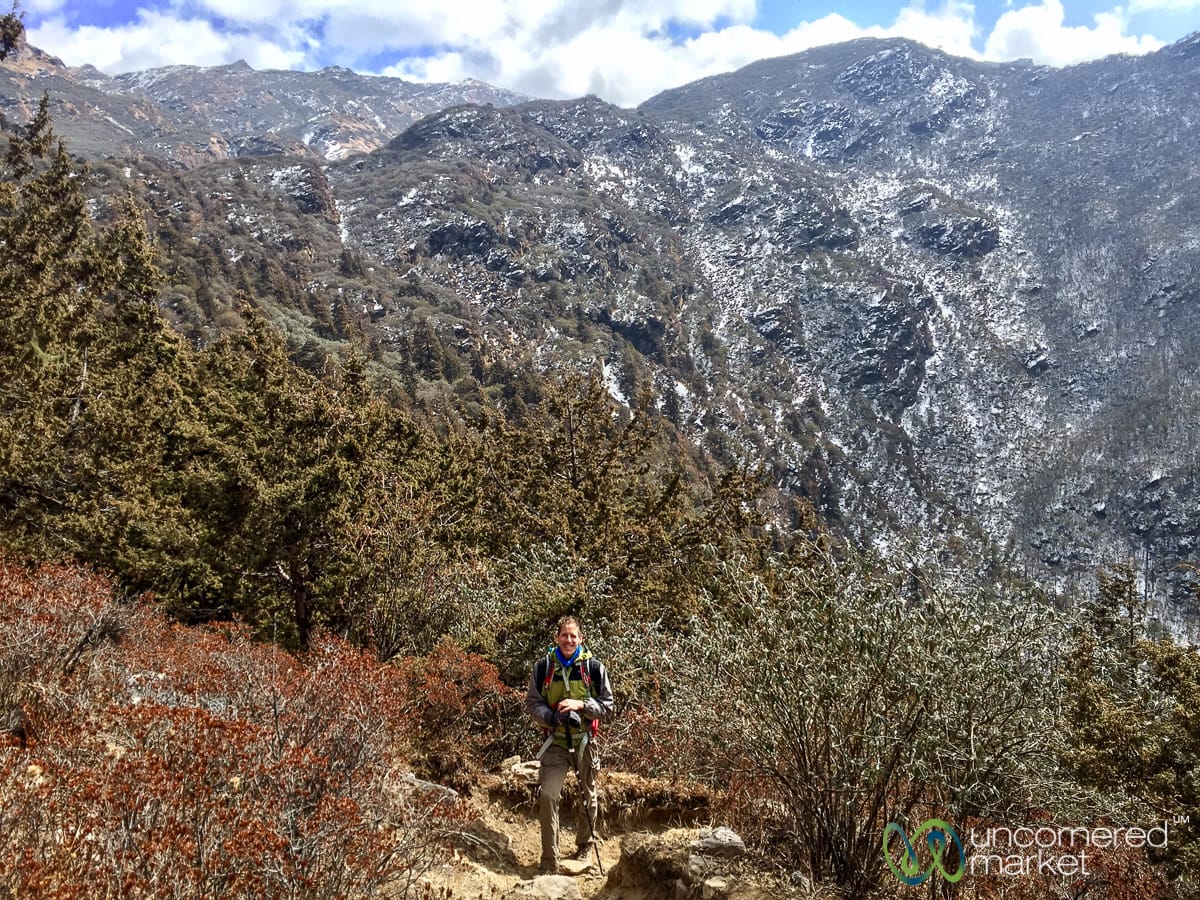

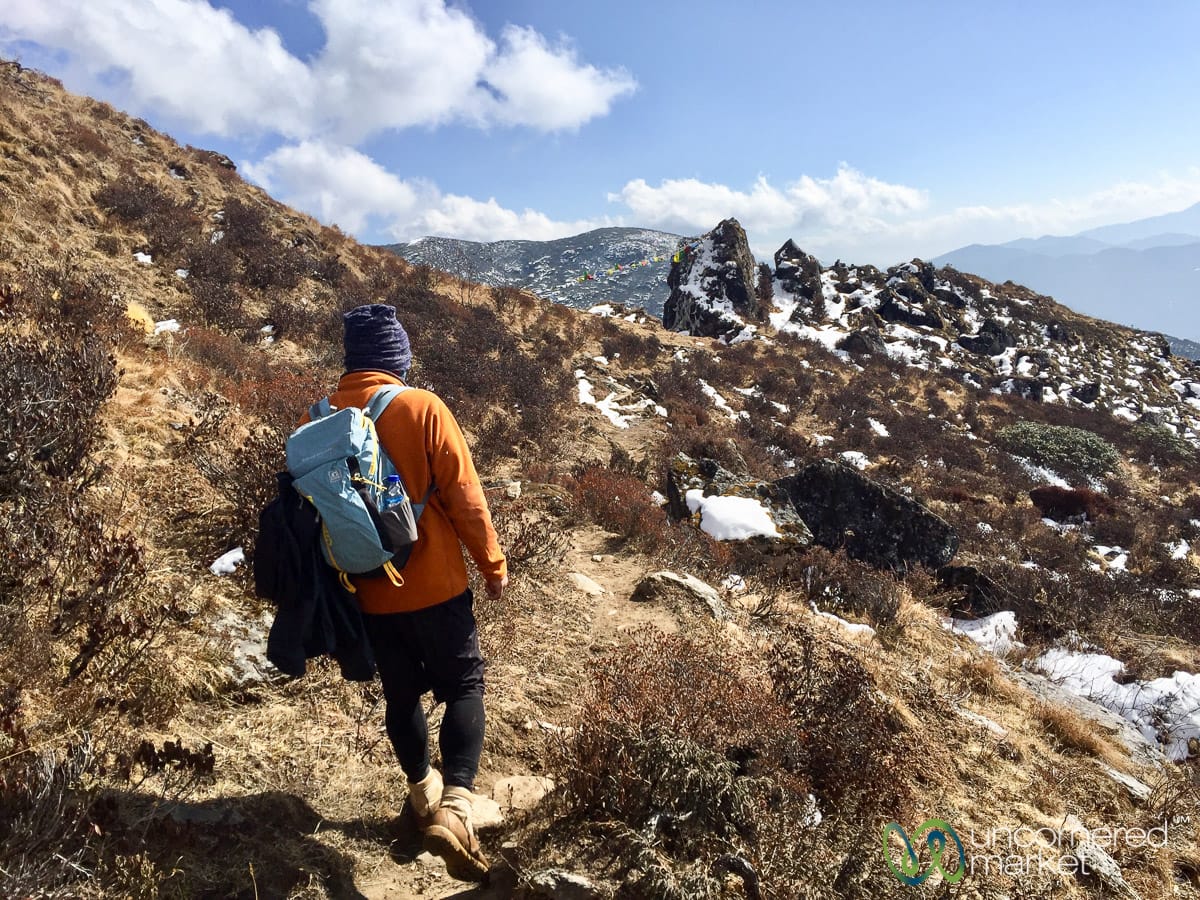
It was a winter trek after all, so we encountered some snow and ice on the trail at this point, so we and the mules had to be careful on the ascents and descents. The path continues along a rocky ridge until you reach Janye Tsho, an overlook draped with prayer flags and offering views of the nearby snow-covered Himalayan mountains in the distance.
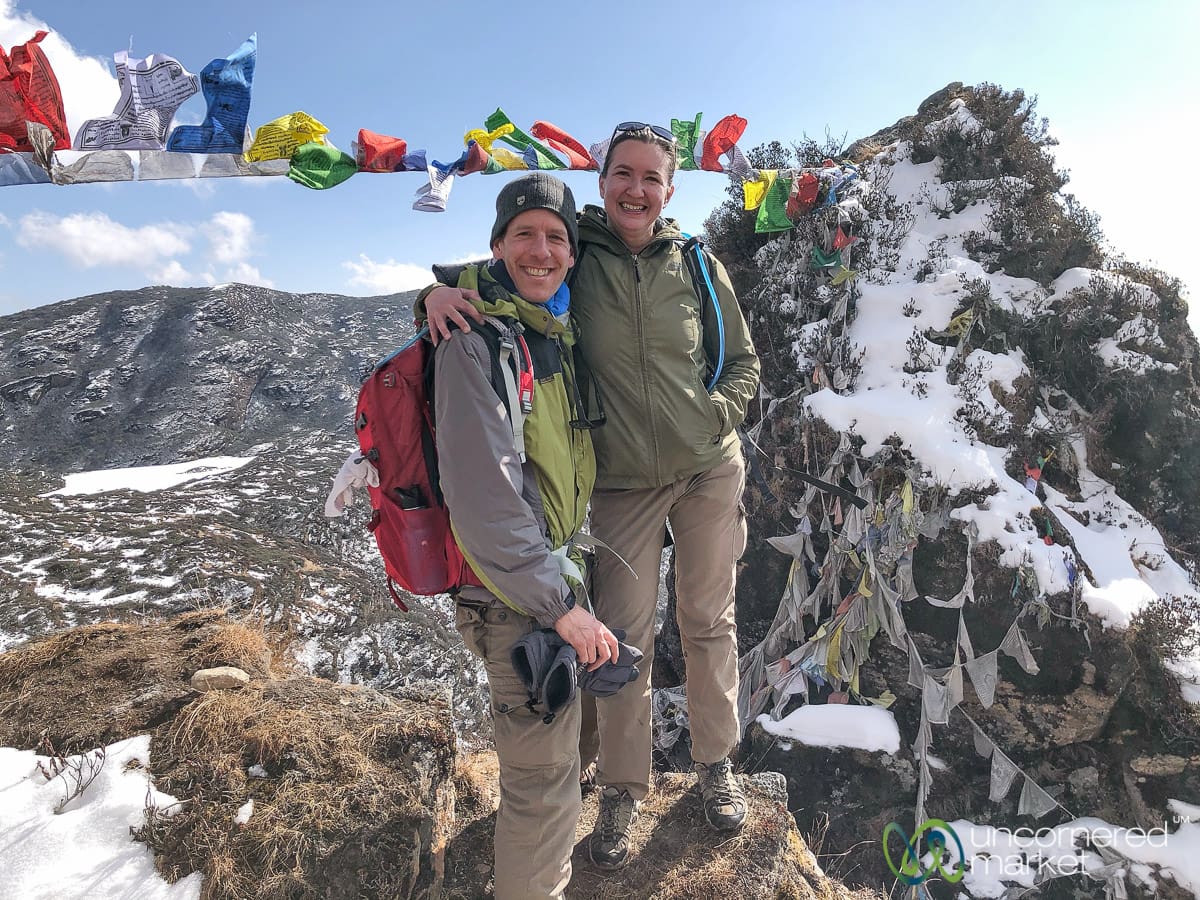
It's an easy and short walk from here to the campsite near Simkotra Lake at 4,000 meters / 13,100 ft. As this is the highest elevation campsite of the Druk Path Trek, expect it to also be the coldest campsite at night. Be sure to bundle up with lots of layers, especially if you are doing the trek in winter, early spring, or late fall.
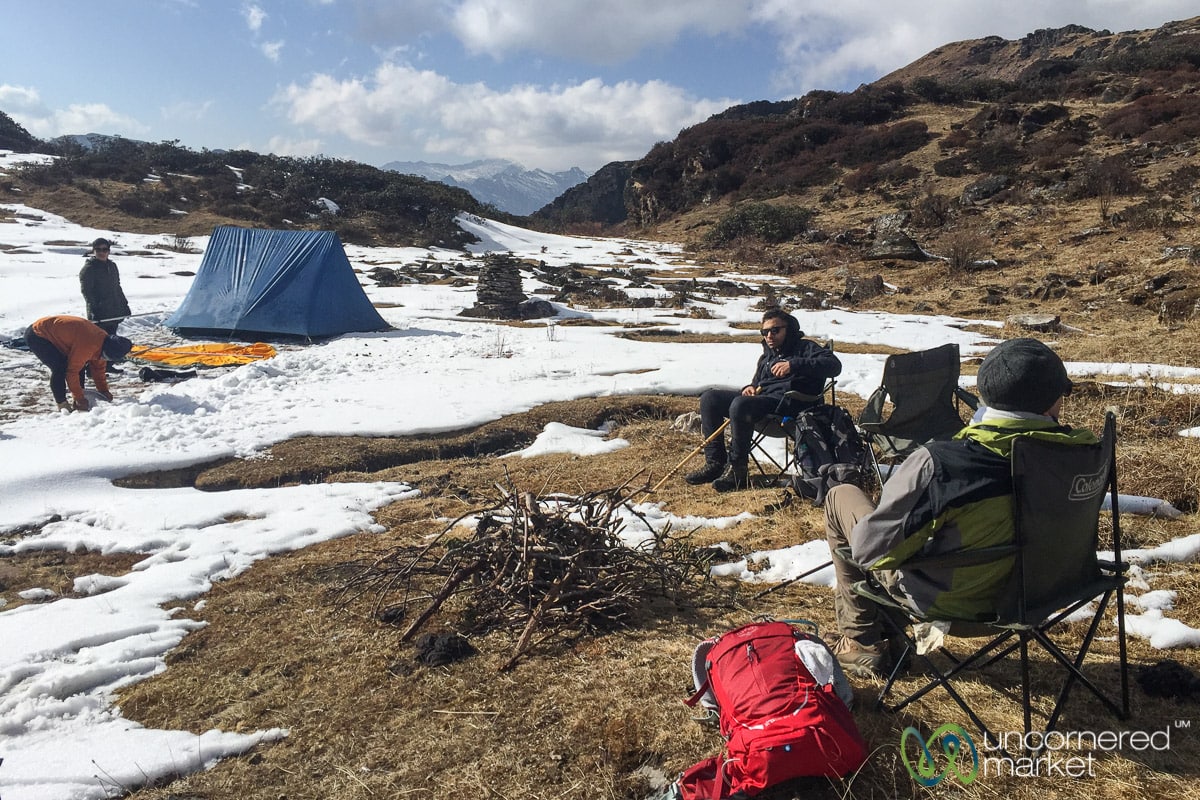
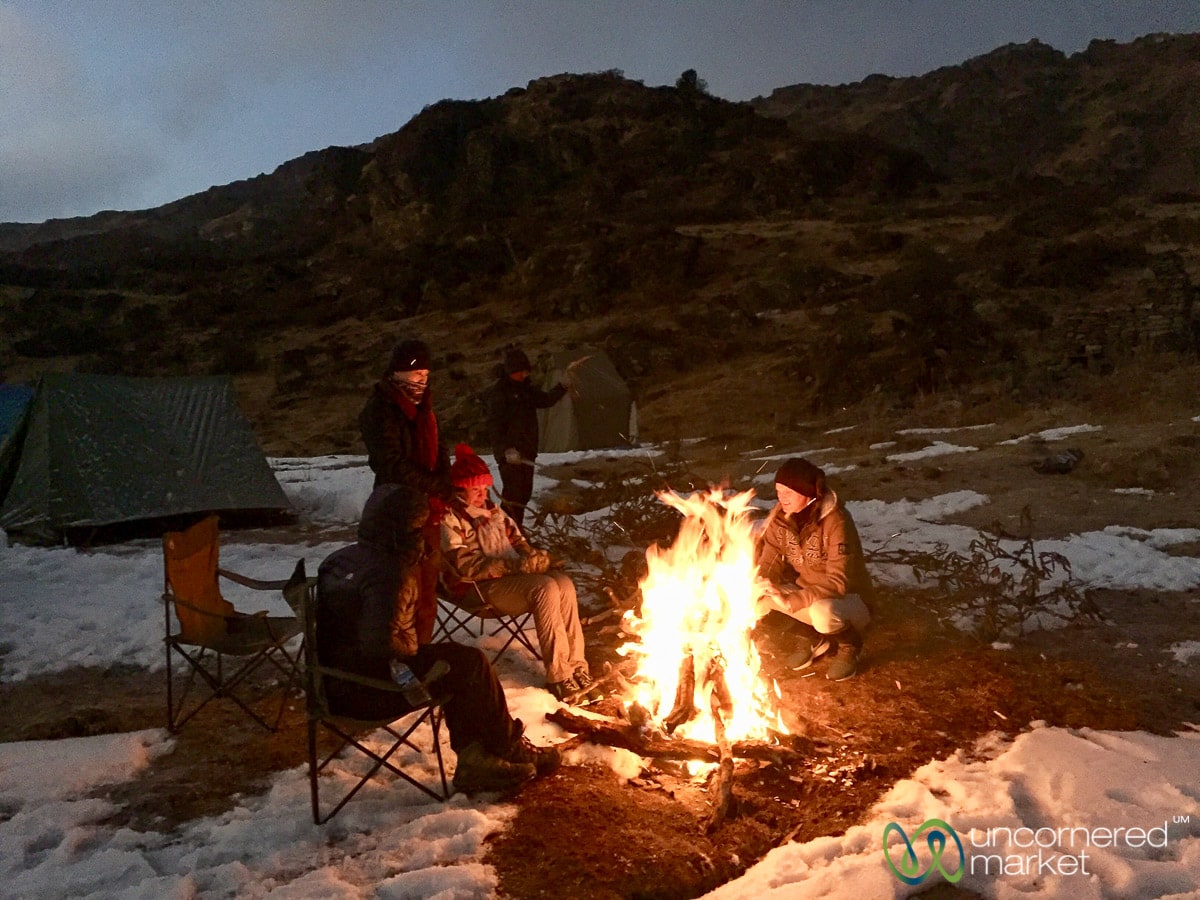
Day 3: Simkotra Lake to Labana Pass to Phajoding Monastery
This was my favorite day of the Druk Path Trek as it not only took us to the highest point of the trek — Labana Pass at 4,200 meters / 13,800 ft — but it was also filled with a diversity of landscapes, experiences and views. Note: Sometimes trekking groups camp before Labana Pass making it part of the fourth day.
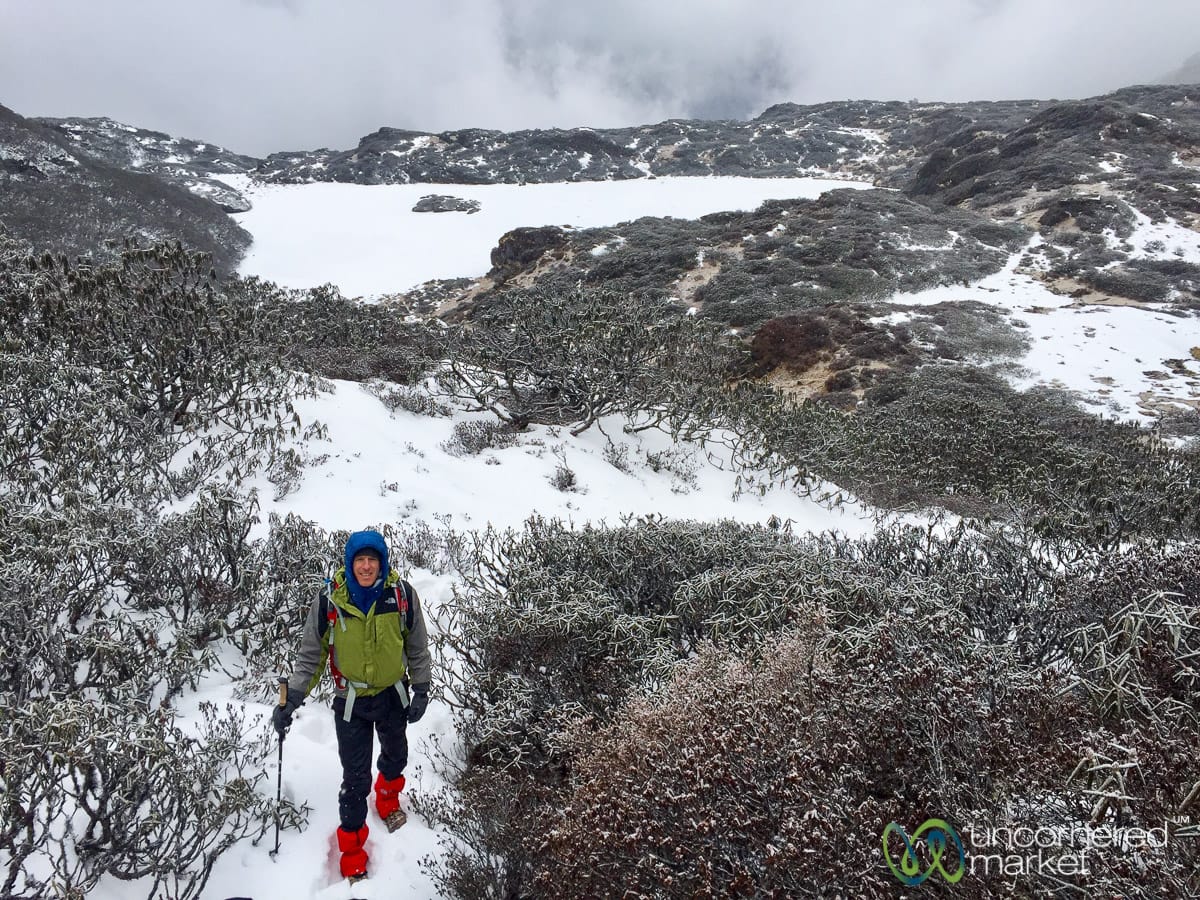
We woke up to a blanket of snow everywhere at Simotra Tsho. This meant that some of the views we were supposed to have that morning of the high Himalayas were obscured by the clouds. Instead, we enjoyed some remarkable landscapes in the beauty of their winter stillness and silence as the snow continued to fall for the first couple of hours.
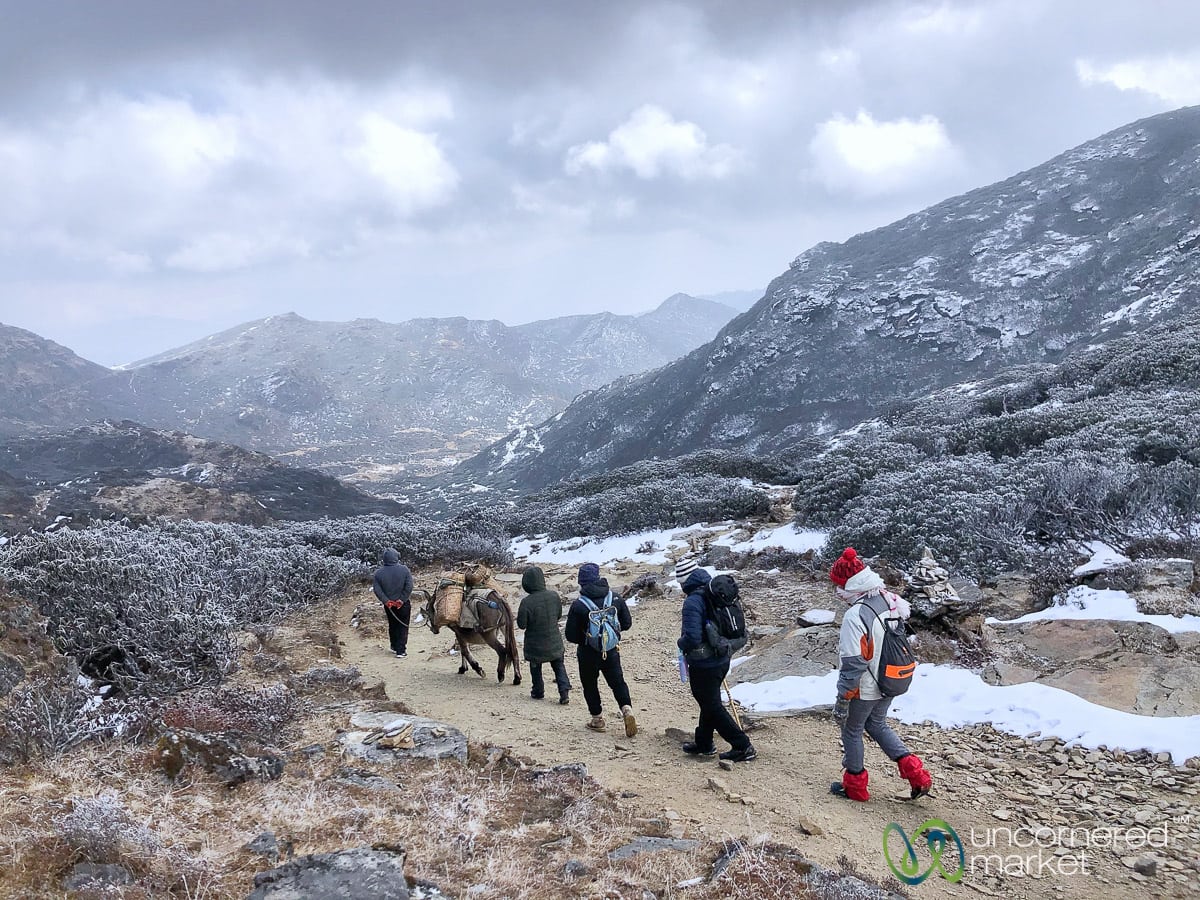
The trail is a combination of a gentle uphill and flat through endless rhododendron patches until you reach the final ascent towards Labana Pass (4,200 meters / 13,800 feet). This final push is a bit steep, but you'll be rewarded at the top with prayer flags and excellent vistas, including of the valley below and of the snow-covered mountains of Dochu La and Jhomolhari in the distance.
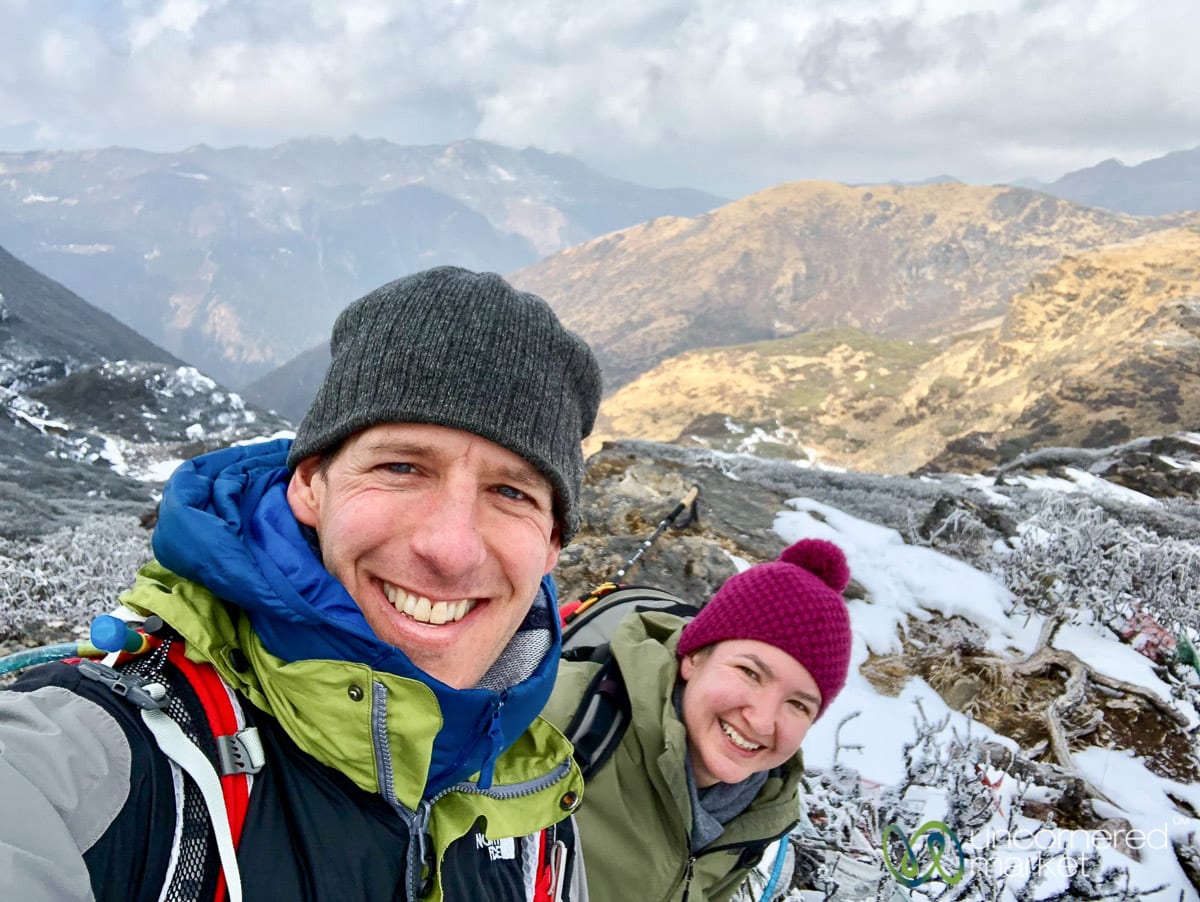
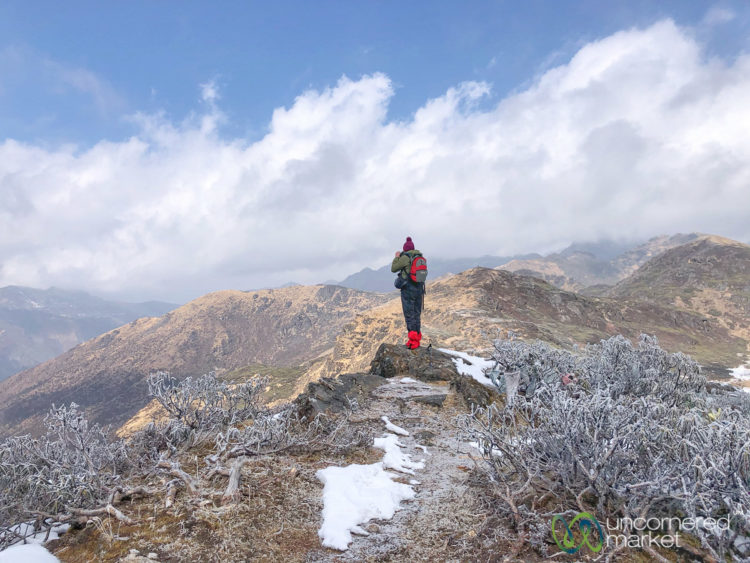
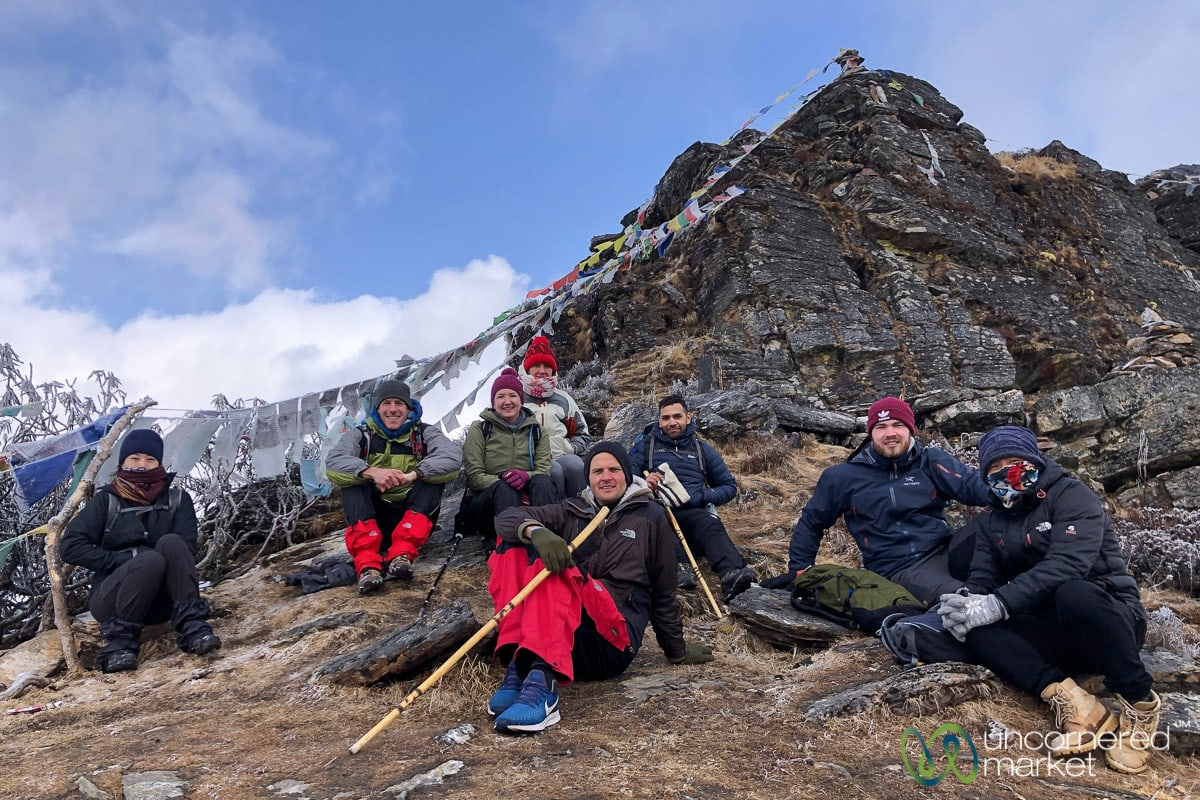
The trail then descends into the valley on a rocky ridge path for another hour or more. We stopped for lunch before continuing up along a chain of small hills until we reached a chorten atop one final peak overlooking Thimphu, Bhutan's capital city.
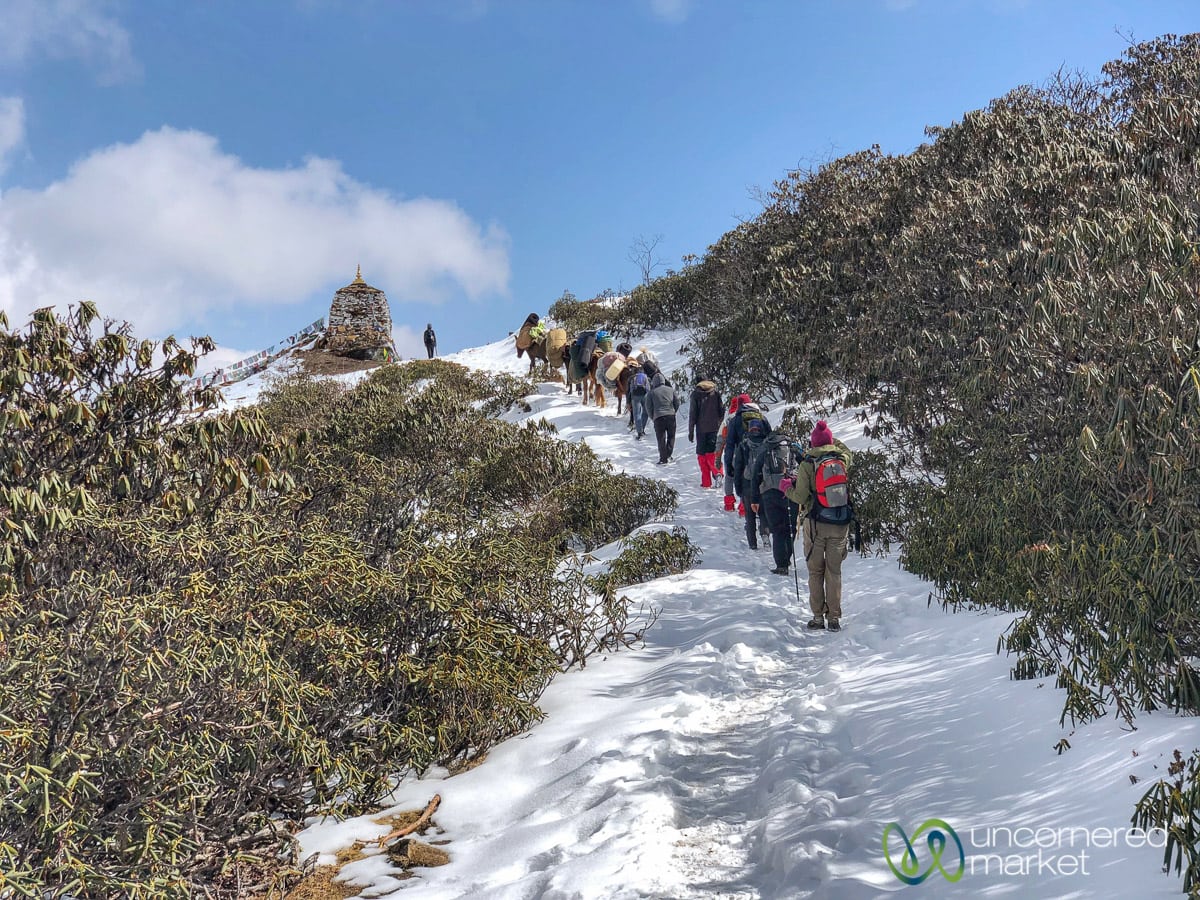
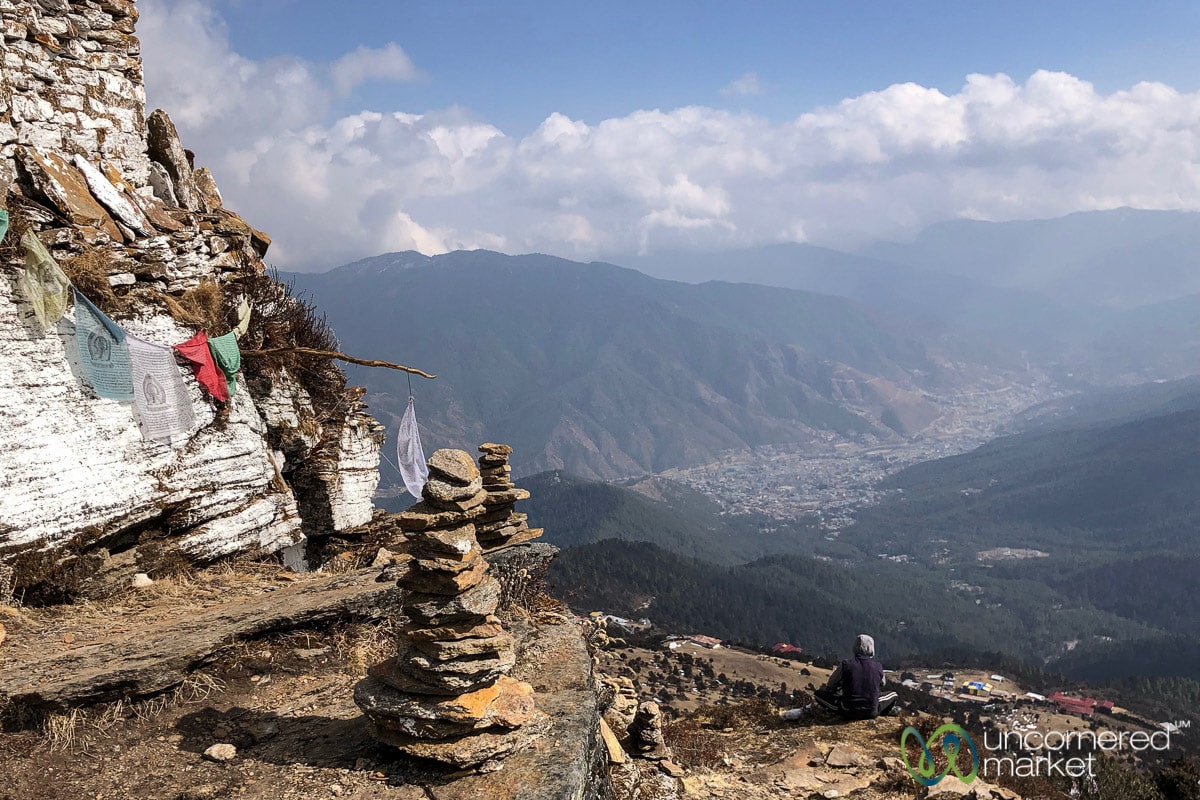
Descend into Thimphu Valley on a rocky trail for around 30-45 minutes until reaching Thujidrak Goemba, a Buddhist temple and meditation center stitched into the mountain rock face at 3,950 meters / 13,000 feet. We were fortunate that a local monk was around. He let our group inside to see the 14th century temple.
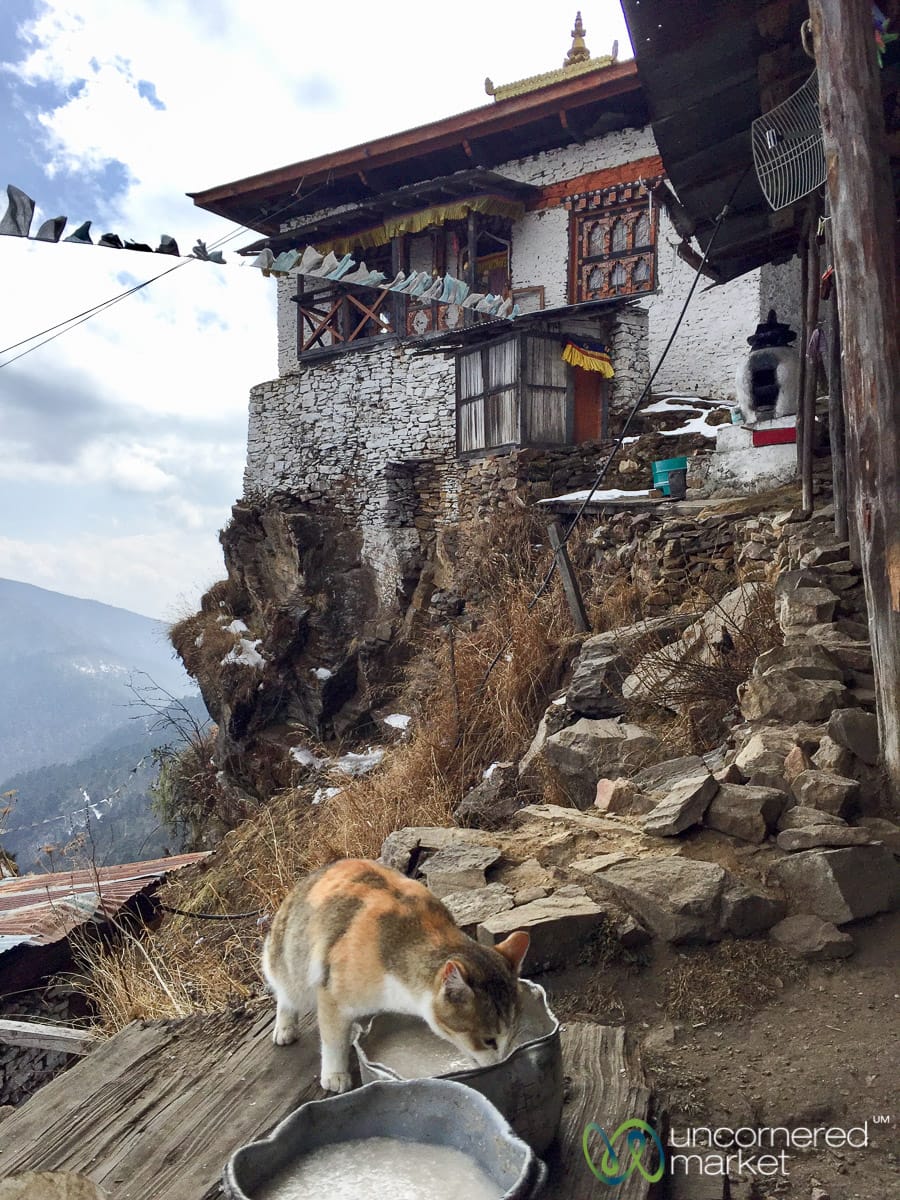
From there it was an easy walk downhill through fields to reach Phajoding Monastery. The camping area on the monastery's edge had recently been closed to trekkers so our group ended up staying, with the permission of the resident monk and school principal, in the monastery's abandoned schoolhouse.
Since temperatures dropped quite considerably that night, we were thankful for the protection the building provided from the wind and cold. However, a new camping area is being set up for future groups.
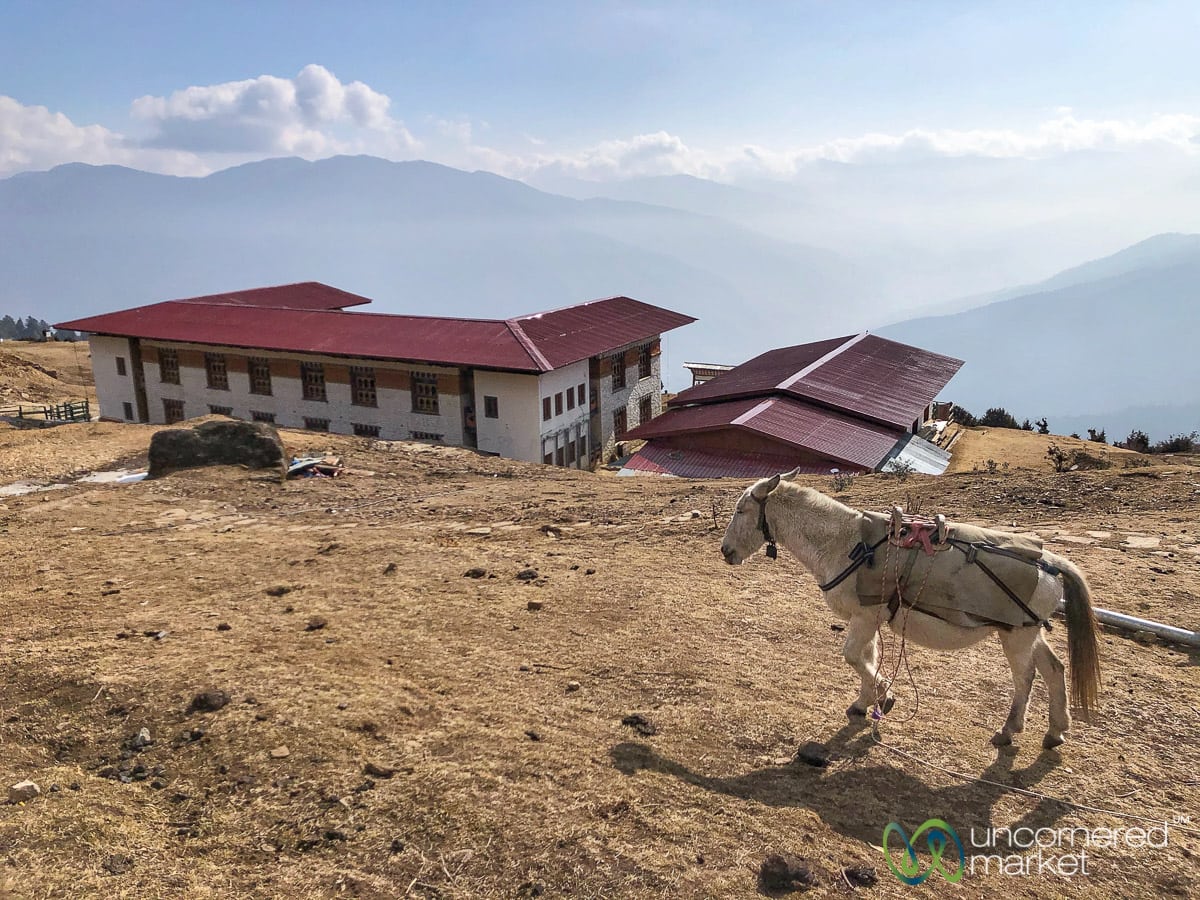
Day 3: Phajoding Monastery to Thimphu
This final day is very easy, with a relatively short downhill hike. The dirt trail from the monastery continues through the forest, and becomes steep at times, so use your walking sticks and be careful.
As the elevation decreases, the trees and flora begin to change. You hear signs of “civilization” below as cars and trucks use the mountain roads.
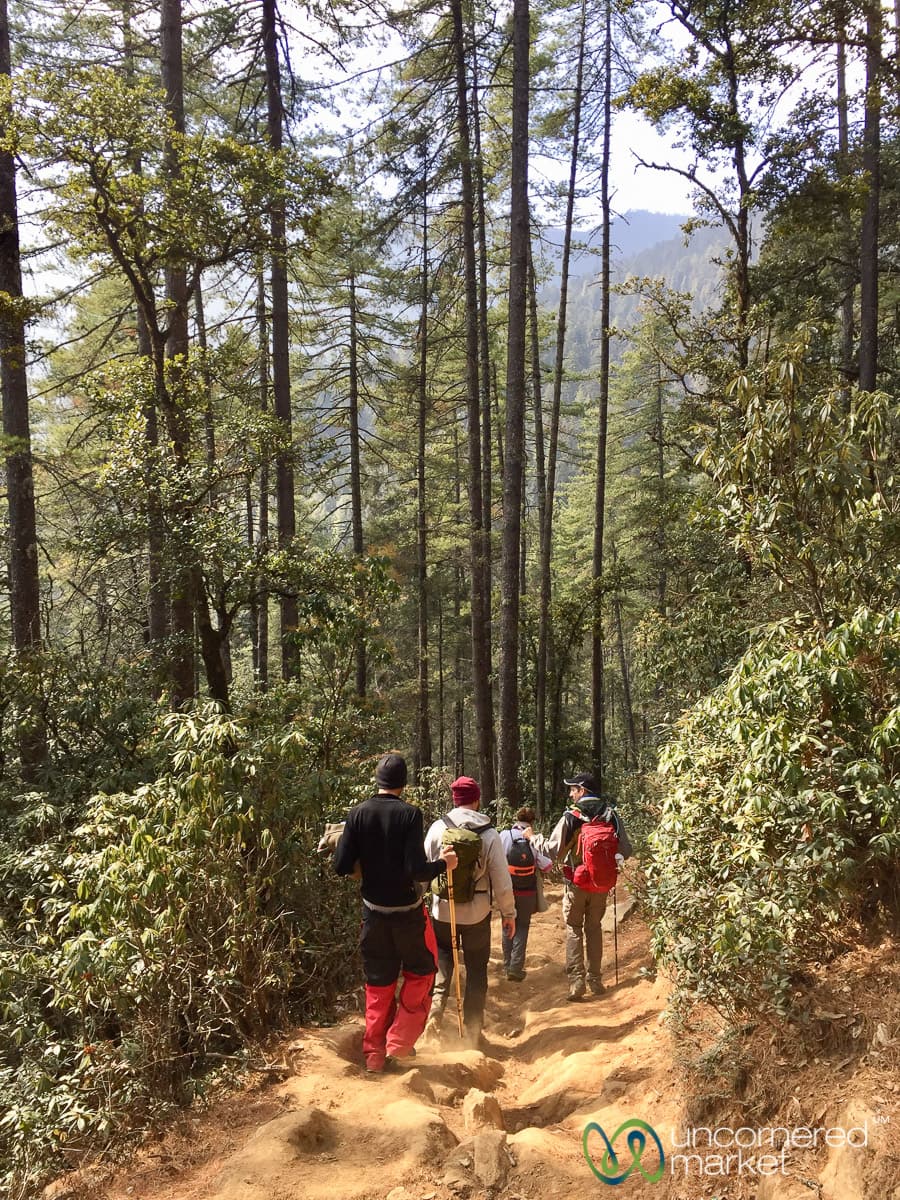
The trail ends at the edge of the forest, near one of the prince's residences. Our tour driver met us with a big smile, a selection of local beer, cake and other snacks. This is where you'll say goodbye to your trekking support team and the mules that carried all of your gear during the trek.
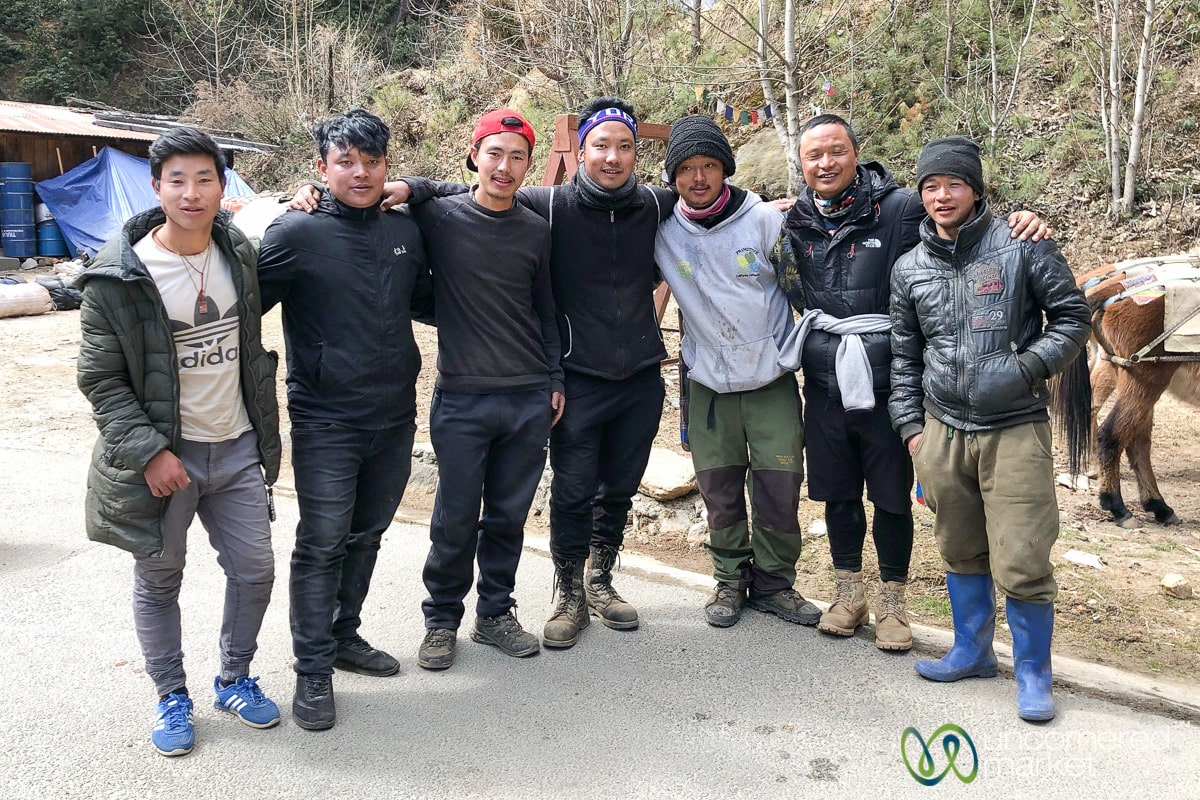
Bhutan Trekking Difficulty Level and Conditions
We’d give the Druk Path Trek a medium difficulty ranking given its length, inclines and altitude. You should be accustomed to or be prepared for slow, steep uphill climbs at reasonably high altitude. A couple of the people in our group felt that the long ascents and hills on the first day were quite difficult, but this broke them in and they didn't have problems with any of the climbs during the rest of the trek.
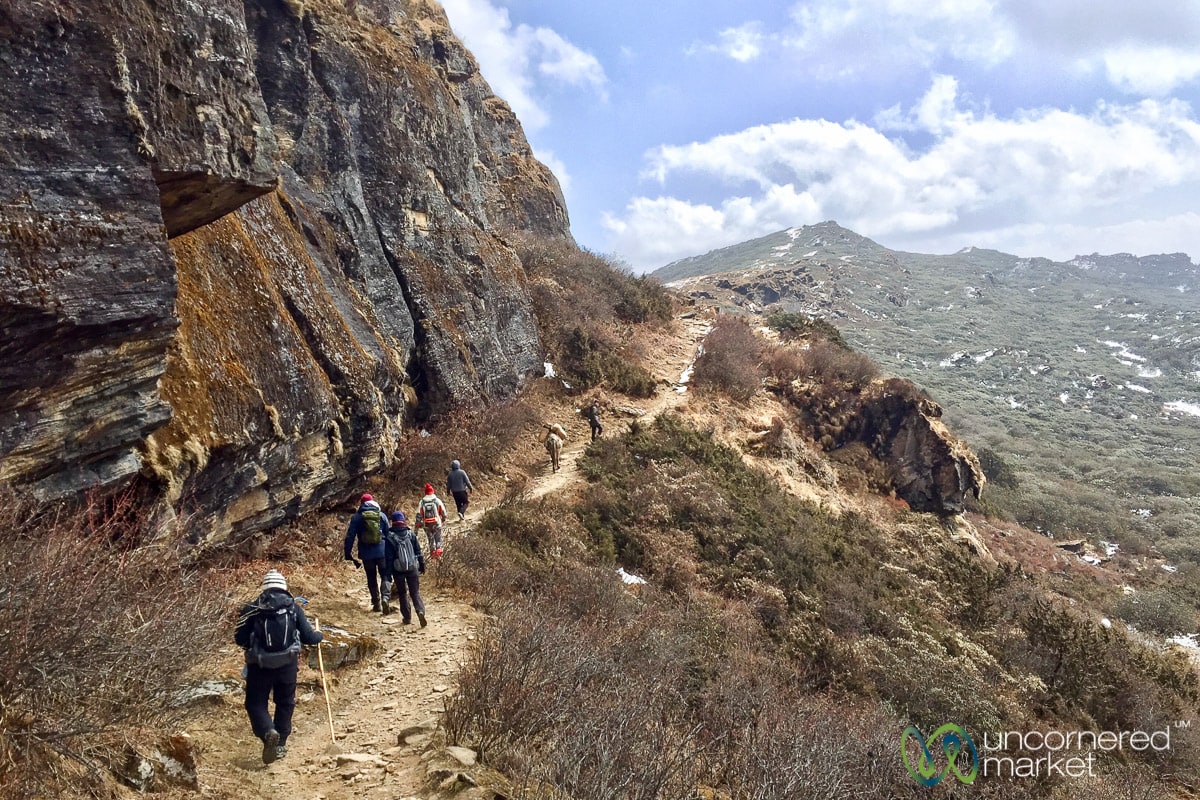
If you are already relatively active and have some experience trekking at altitude you shouldn't have any problems along this trek, nor should you require special training. However, if you don't have a lot of hiking experience then consider doing a series of long day hikes, preferably with hills, prior to this trek. In addition to preparing you physically, this will help build your confidence.
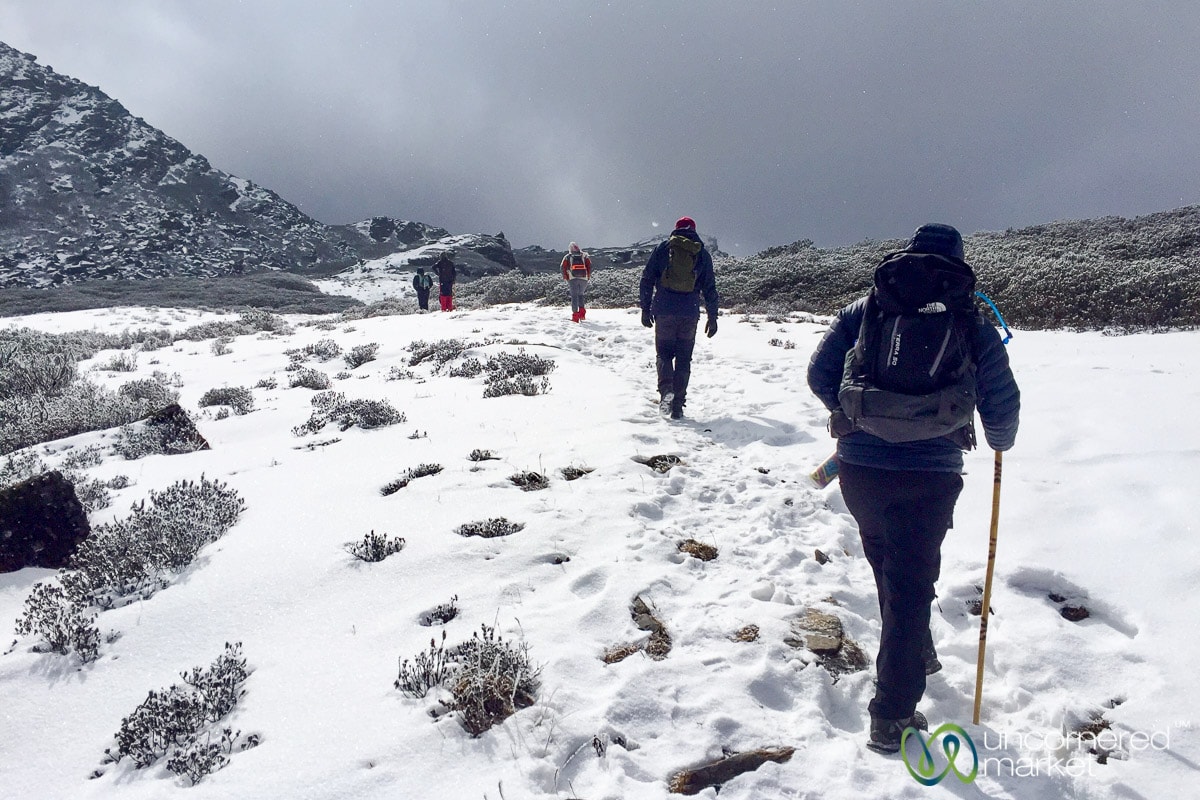
The winter conditions made this trek a bit more challenging for us at times as we had to watch our footing more in the snow and ice. Nights were also very cold (down to -10 C / 14 F). This did not impact the trek experience or its difficulty much.
The Druk Path Trek is not technical, meaning that you will not need any special equipment (e.g., climbing ropes or other fittings) or training. The trail is well-maintained and is easy to follow. Even in the winter, none of us had any special ice or other gear, just some gaiters to prevent the snow from getting in our shoes.
Dealing with Altitude When Trekking in Bhutan
The Druk Path Trek does take you pretty high, up to 4,200 meters / 13,800 feet, at its highest point. In addition, the first two campsites are just below and just above 4,000 meters / 13,100 feet. This means that you need to be prepared for hiking and sleeping at altitude. If you don't have experience at altitude, be sure you talk with your trekking guide about what to expect and possible symptoms of altitude sickness.
Take it slow on the uphills. It's better that you walk at a steady pace and take fewer breaks than to quickly wear yourself out by speeding up the hills and needing to recuperate with frequent and longer stops. Proceeding at a slow, steady pace will also allow your body time to adjust to the high elevation.
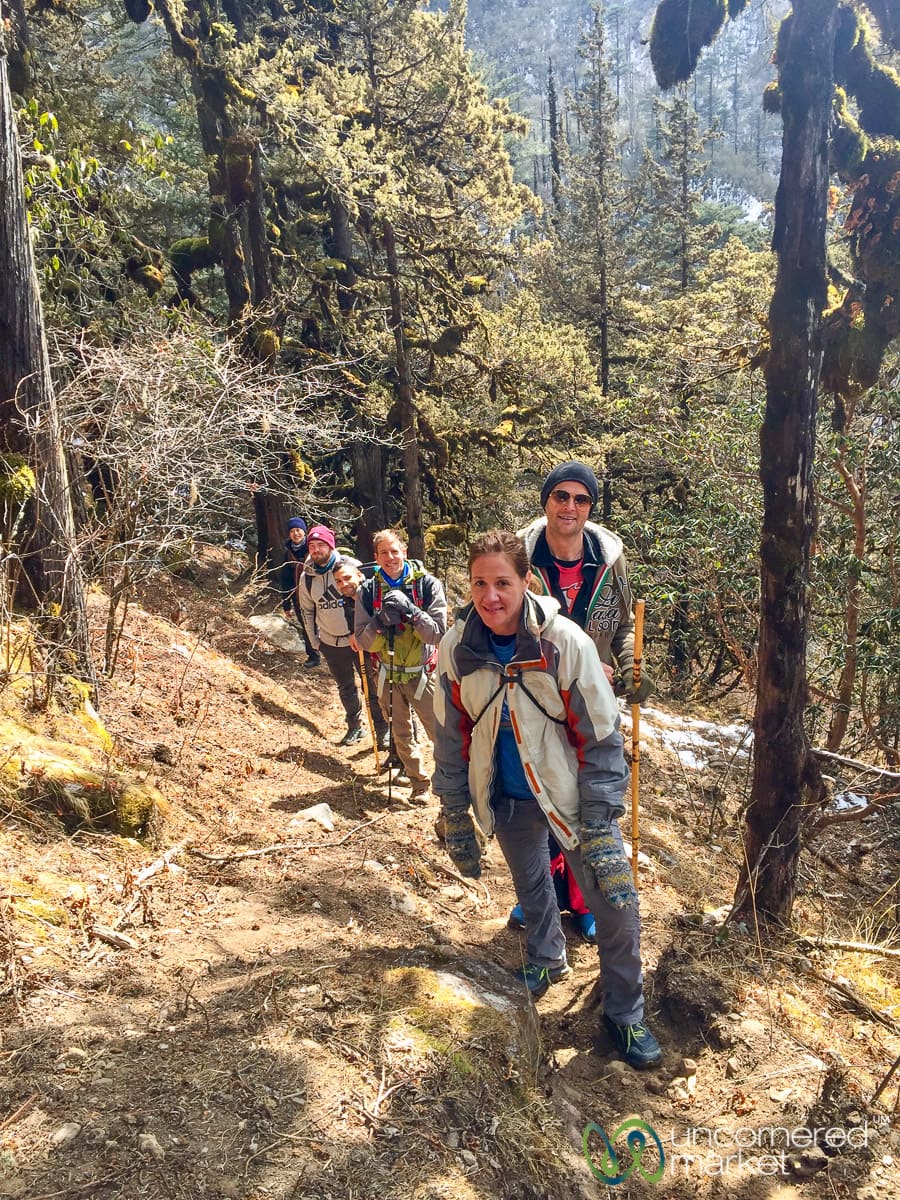
Be sure to drink lots and lots of water, as in liters per day. This is one of the best ways to prevent potential altitude sickness. Consider using a water bladder in your day pack and drink from it regularly as you walk. I find I drink more water this way than with a water bottle, that usually requires a stop to get it out the bag.
Our tour included an acclimatization hike to Kila Goempa outside of Paro. This helped us adjust to the terrain and the altitude. If your tour does not include this, be sure to ask for an acclimatization hike. Acclimatization is important to gauge how your body reacts to altitude. It also prepares your body for the multi-day trek ahead.
Snow, Rain and Mud Along the Druk Path Trek
Since we chose to do the Druk Path Trek in winter (late January/early February), we understood that we might encounter snow. We packed — and at times wore — waterproof/water resistant pants, jackets, and gaiters to protect us from the snow, wet and cold.
We did not find the snow and winter conditions a problem, but a feature and differentiating factor of this trek and timing it in winter.

During other times of year, especially in May as you get close to the rainy season, you might encounter some rain and mud along the trail. It's always good trekking practice to carry waterproof layers or a rain poncho with you to protect you and your daypack from rain and the elements.
See the packing list section below for recommended trekking gear to pack to keep you warm and dry, and protect you from the elements.
Food Along a Trek in Bhutan
You will certainly not go hungry while trekking in Bhutan! Each trekking group is assigned a cook and a couple of helpers. In addition to three hot meals per day you will also have several tea breaks and snacks (e.g., cookies, popcorn) along the trail and when you arrive at the campsite.
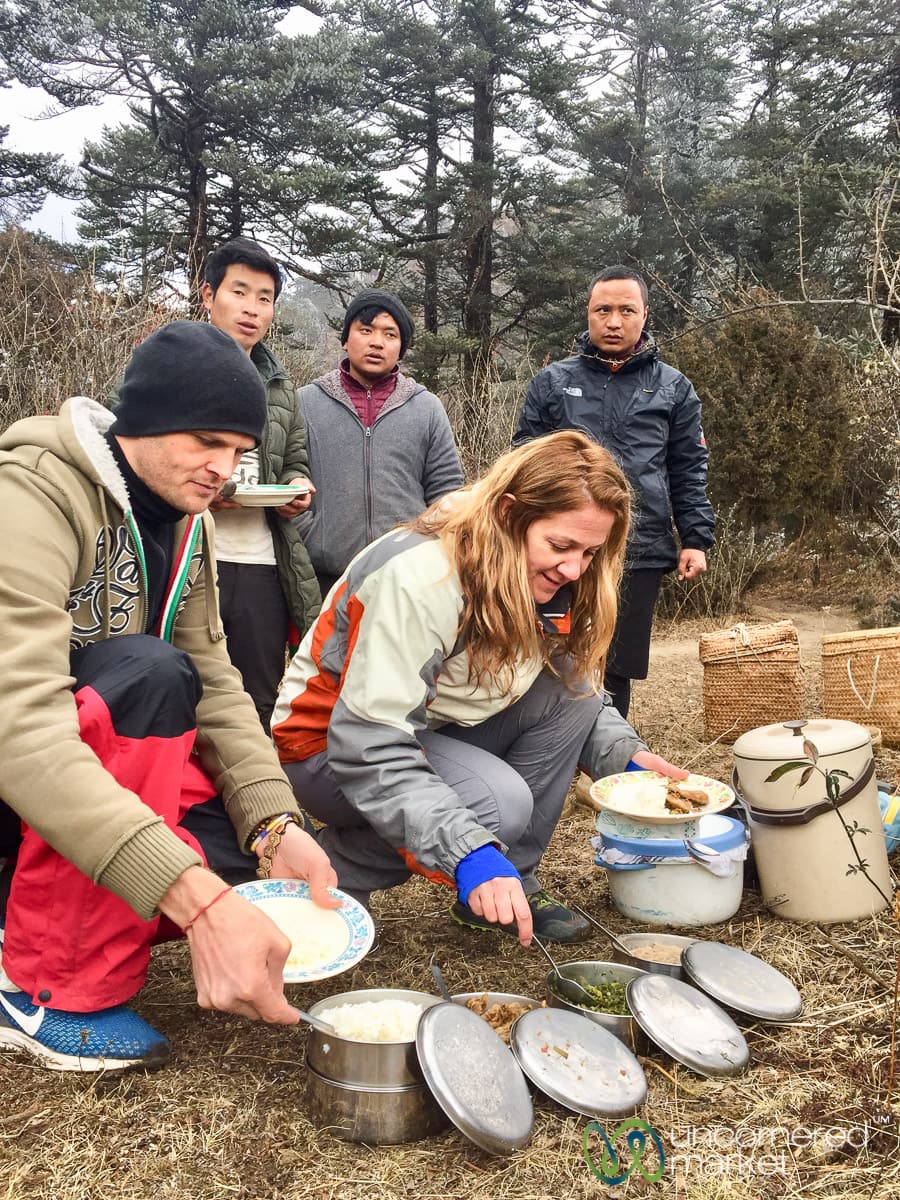
On our Druk Path Trek, breakfast included a combination of a hot dish (e.g., eggs or oatmeal) with toast and different toppings (peanut butter, jam, honey, etc.). For lunch and dinner expect several options of Bhutanese vegetarian dishes (e.g., chili and cheese, sauteed greens, vegetables and cheese, etc) and a meat dish or two (e.g., chicken, beef or pork curry) served with rice or noodles. We ate mainly from the vegetarian options as we prefer lighter, vegetarian meals when we trek.
If you are vegetarian, vegan or have food restrictions (e.g., glucose or lactose intolerance), alert your trekking company and your guide in advance so they can respond accordingly.
Campsites and Sleeping Arrangements
The Druk Path Trek has a few standard campsites that are located on flat ground and near a water source. By the time we would arrive at the campsites, our 2-person tents and sleeping mats were already set up for us by the trekking support team (luxury, I know!). A large tent is also set up for eating meals together.
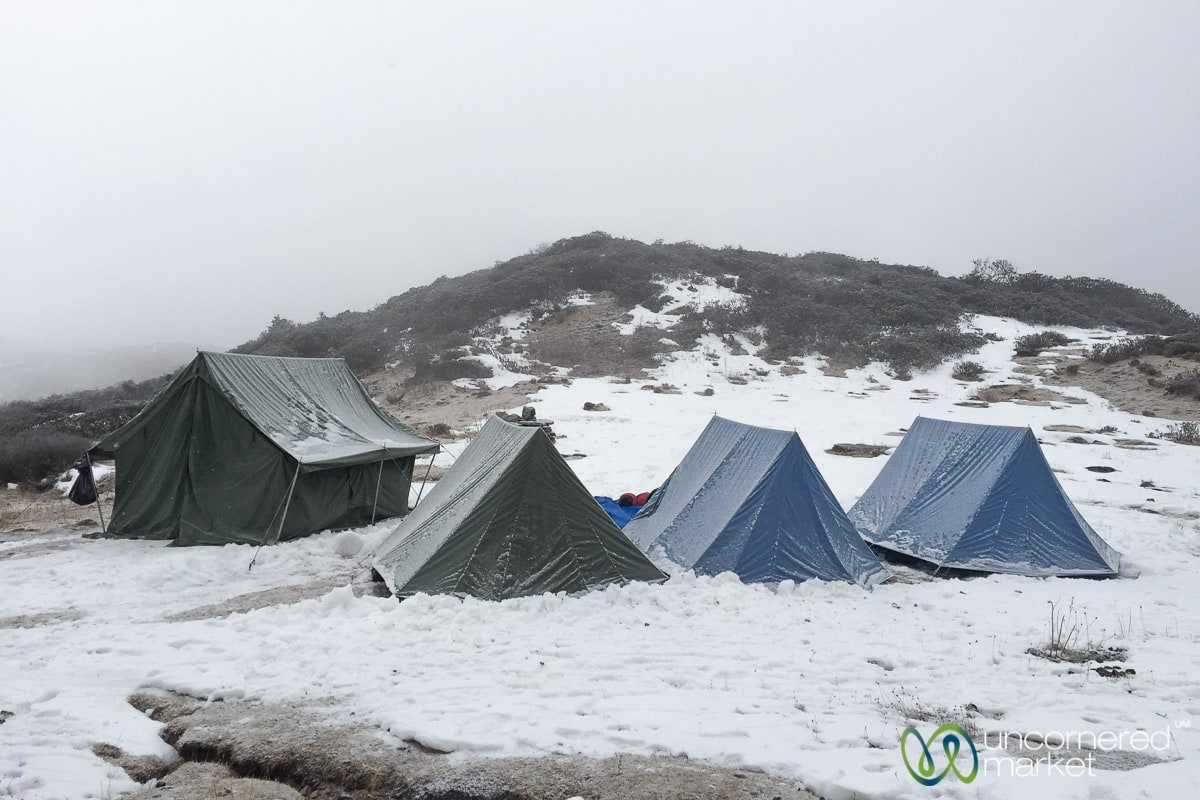
At night we would usually have a bonfire made from dead or fallen tree or bush branches (it's illegal to cut down branches) to warm us up as it got rather cold once the sun went down. Just before bedtime we were given hot water bottles to put in our sleeping bags – so nice!!
Each morning hot tea or coffee was delivered to our tent at around 6:30 AM as a wake up call. A bowl of hot water followed to wash our face, hands, etc. We would then pack up the stuff in our tent before taking breakfast in the dining tent at around 7:00AM.
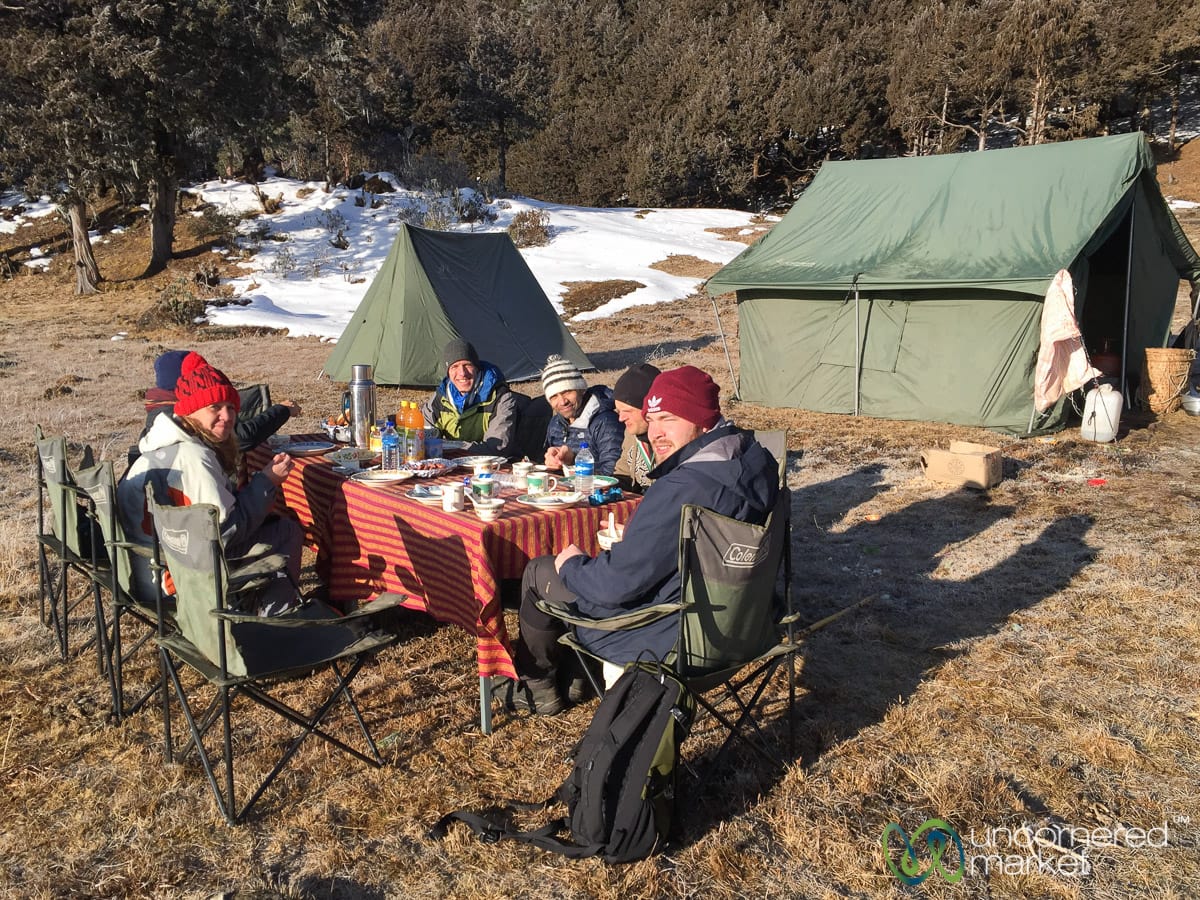
There are no showers or permanent toilets set up at the campsites, but the trekking support team set up a camping latrine or toilet at each one. Please use this instead of going off into the woods so that all waste and toilet paper is collected and disposed of in one place.
Best Time to Go Trekking in Bhutan
The high season for trekking in Bhutan, including the Druk Path Trek, is in the spring months of April and early May when the rhododendron bushes and trees are in blossom. September, October and early November are also considered good times to trek because it's dry, warm and the skies are clear.
The summer months from late May to July are usually not considered a good time to trek as this is the rainy season so you would likely encounter muddy and rainy conditions, as well as clouds blocking views of the surrounding mountains.
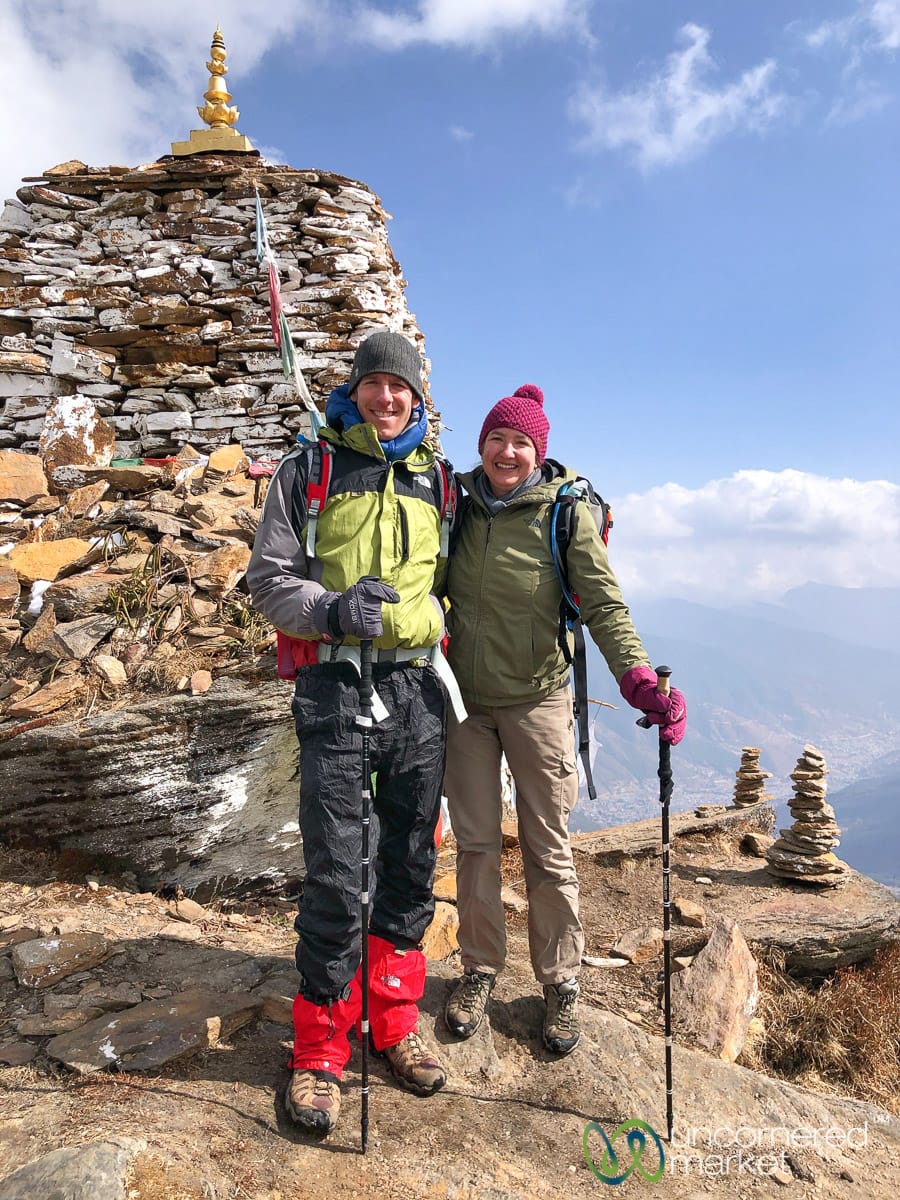
Although winter (January – February) is not considered a recommended time to do the Druk Path Trek, we actually enjoyed it. The snow and winter weather added another dimension to the experience and we had the trails and campsites to ourselves. It can get very cold at night (-10 C/14 F), however, so it's important to pack a warm sleeping bag, lots of warm layers, and waterproof gear.
All this said, weather in the Himalayas is highly variable.
Organizing a Trek in Bhutan
Choosing a Bhutan trekking company
You cannot trek in Bhutan independently, meaning you must go with an authorized tour operator in Bhutan. This means that your trek will be fully supported, including a trekking guide, cook, helpers, and a team of mule porters to carry your trekking and camping gear. The same minimum daily package fee for Bhutan applies on treks as well.
Our Druk Path Trek was with G Adventures and was part of a larger 11-day tour to Bhutan. We recommend this as the tour combines several days on the trek where you are immersed in nature with visits to temples, fortresses and towns to learn more about Bhutan's culture, religion, people and history. Note: The Druk Path Trek tour that we took no longer exists, but both the G Adventures Camp the Trans Bhutan Trail (11 days) and Highlights of the Trans Bhutan Trail (12 days) offer a similar combination of trekking with exploring Bhutan's monasteries, historical sites, villages and towns.
For more details on how to get a visa to Bhutan, minimum daily package fees, flights to Bhutan, and more, check out our Bhutan Travel Guide.
Packing for a Trek in Bhutan and Leaving your Luggage Behind
For the Druk Path Trek and other treks in Bhutan with G Adventures (and other trekking agencies), you are allowed to bring a maximum of 7.5 kilos per person for the mules to carry. This includes your sleeping bag, clothes, toiletries, towel and any other trekking gear you might need at night.
We carried a day pack with us during the day with water, camera, snacks, and necessary layers and winter bits like hat and gloves.

We left our big bags or luggage behind with our tour driver in Paro. We took only what we needed for the trek with us. At the end of the trek, when we emerged from the mountains all our luggage was waiting for us in the tour van. It was available immediately when we arrived at our hotel in Thimphu.
Bhutan Trekking Packing List
Much of what we include in our How to Pack for a Trek article applies here. However, we offer a customized Bhutan Trekking packing list based on our Druk Path Trek. It has a special focus on winter trekking as this was our experience, to ensure you have what you need to stay warm and dry in all conditions, but that you don't overpack.
Remember that you will not have access during the day to the bags with the 7.5 kilos/person of gear so this bag should only include things you need at night. All our waterproof gear and jacket layers we carried with us in our day packs. Better to be prepared as you never know when the temperature and the weather might change as you walk.
Even with these layers, try to pack your day pack as light if you can. You’ll quickly begin to feel the extra weight going up those steep hills.
Drinking Water
You should consume several liters of water each day (if not, then you’re not drinking enough) since you’ll be walking at altitude most of the time. Bring with you a refillable water bottle or a water bladder (or both) so that you always have at least one liter of water on you at all times. I find that I drink more water on the trail when I drink from a water bladder so I carry both.
For hygiene and safety, you'll have access to boiled water at the campsites. This can be used for tea and coffee, but it is also what we used as clean water to refill our water bottles. If you really want to play it safe consider carrying with you a SteriPEN, sterilization drops or a water bottle that includes a filter.
Trekking Daypack
Recommended Women's Trekking Daypack
Deuter ACT Trail Pro Backpack: Very light with all sorts of great functionality like a built-in rain cover, water bladder compatibility, wide waist belt for stability, and more. I have the 32-liter, but you could go with a smaller 28-liter option for this trek as you don't need to carry that much during the day. Buy on Amazon | Buy on REI (28-Liter) | Buy on Backcountry.com (34-Liter)
Recommended Men's Trekking Daypack
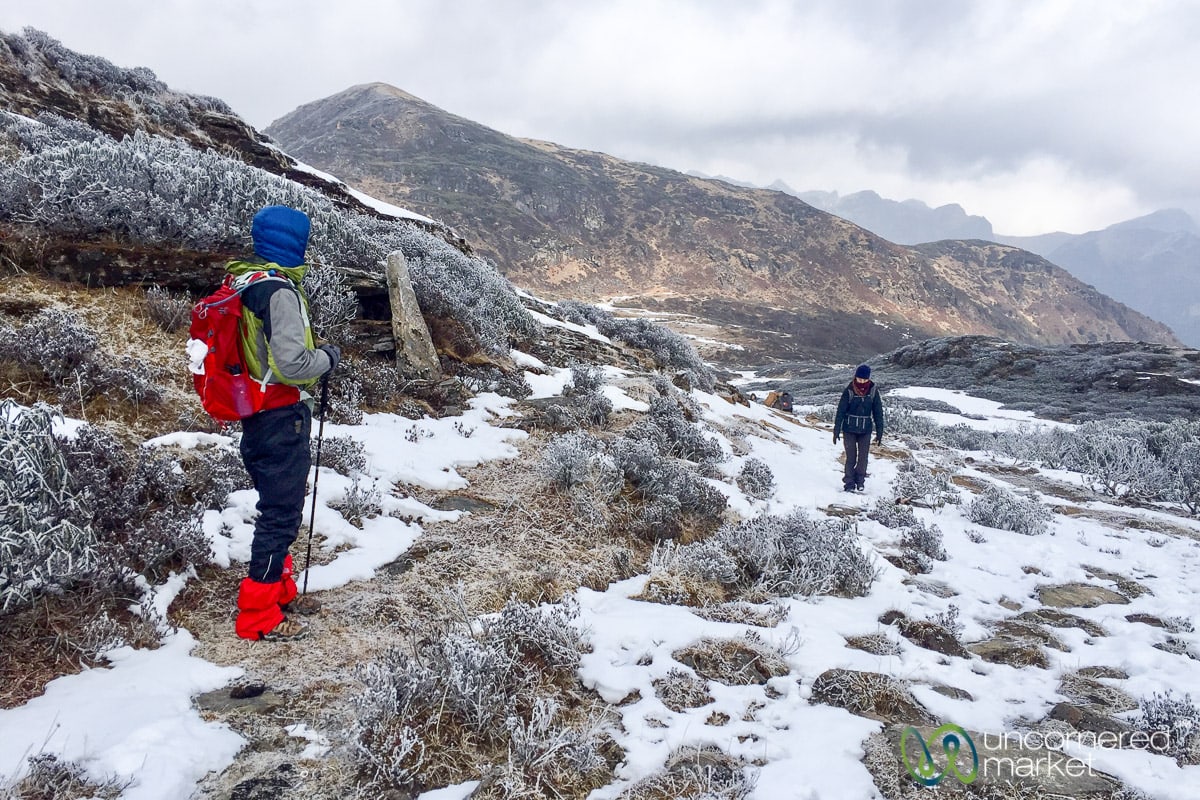
Osprey Packs Stratos Men's Hiking Backpack: Dan is a big fan of Osprey packs as they are adjustable and fit his back and torso well. The 24 – 34 liter size is great for day hikes or as a day pack on multi-day treks like this. Buy on Amazon | Buy on REI | Buy on Backcountry.com
Sleeping Bag
It's very important that you bring a warm sleeping bag so that you are not uncomfortable in your tent at night. We highly recommend getting a sleeping bag that is COMFORT rated to -10 C/15 F (or even warmer). Even if you don't trek in the winter time it still gets rather cold at night and it's better to take off layers or unzip the bag than to not be warm enough.
We purchased this Mammut Nordic OTI winter sleeping bag, which was warm enough, synthetic (vs. down, which requires more care) and came at a great price. However, it's a bit bulky and took up quite a bit of space in our luggage.
Another good sleeping bag option would be one of the down sleeping bags offered by Hyke & Byke (e.g., this sleeping bag goes down to 0 degrees F) as they are very reasonably priced for down and the quality of the bags. Here are some other winter sleeping bags offered at REI.
Trekking Poles / Walking Sticks
We highly recommend carrying trekking poles. We were very thankful for ours, especially on the steep downhills and when the trail was covered in snow and ice. We brought our own set of travel trekking poles (they fold up compact) with us. We share one set between the two of us so that we each carry one pole on the trail.
If you didn't bring walking sticks with you ask your guide if you can rent or borrow them. Our guide made several wooden sticks available for people in our group who didn't have them. They were very thankful to have them.
Clothing to go Trekking in Bhutan
You don't need a lot of clothes, but you do need the right layers. Don’t worry about packing clean clothes for each day, as you can just re-wear the same things each day. Trust me, no one cares and that's what everyone does. Here’s what we suggest:
- 1 pair of trekking pants: We're both been using Clothing Arts Travel Pants (for men and for women) as our go-to trekking pants for over eight years. They've been through a lot of different treks and conditions, yet remain in excellent condition. We find the additional secure pockets useful on treks for keeping phones, money, tissues and other things handy.
- Thermal underwear (top/bottom): I love my silk long johns as they are warm, comfy and take up almost no room at all. Also good is Uniqlo's Heat Tech collection of thin, but warm, layers of leggings and tops. Dan is still keen on his Patagonia zipper top and bottoms that he's been using for over two decades.
- Short or long-sleeved shirts: I often start with a quick dry t-shirt at the bottom and then add the layers on top. This tends to wick away any sweat quickly so that I don't get cold. On this trek, however, I mainly used a long-sleeve shirt as my bottom layer (e.g., this Uniqlo option or this REI long-sleeved option) as I was aiming for warmth.
- 3-4 pairs of socks: I love SmartWool hiking socks. My first pairs lasted me almost seven years of heavy usage. If you prefer a thinner sock check out their ultra-light line. Buy at REI | Buy on Amazon | Buy on Backcountry
- Hiking shoes: We wore low-rise Oboz hiking shoes and were fine. Other people wore light trainers. However, some mid-ankle support is useful because of the pitch of the terrain, and some traction is the soles is useful when you encounter rain, mud, snow and ice. Men's Obuz Sawtooth Hiking Shoes: Buy at REI | Buy on Amazon | Buy on Backcountry + Women's Obuz Sawtooth Hiking Shoes: Buy at REI | Buy on Amazon | Buy on Backcountry
- 1 set of sleeping clothes: I prefer sleeping in different clothes than the ones I've hiked in all day. So even if it's cold in the tent I'll change into my sleeping clothes as it feels cleaner to me. Given the winter conditions this included a long-sleeve Uniqlo HeatTech shirt, fleece jacket, warm leggings (or fleece-lined running tights), socks, hat, and scarf. To ensure these remain dry, pack them in a plastic bag or other impermeable container inside the bag the mules are carrying.
- Underwear for every day of your trek: With an extra pair thrown in for good measure, if you like. Recommended men's underwear and women's underwear.
- Long sleeved pullover or zipped layer: This thin layer provides an important layer of warmth during the day. Buy on REI (Men's)| Buy on REI (Women's)
- Light fleece jacket: For an extra layer during the day or to keep warm during sleeping, but not too bulky. Buy on REI (Women's) | Buy on REI (Men's)
- Rain jacket: A useful layer for warmth and against the snow, rain or wind. You can use a light windbreaker-in-a-bag that is water resistant or a more substantial waterproof rain jacket like this (women's and men's).
- Down jacket: This is an invaluable layer, especially if you are trekking in the winter, as the jacket compresses into a small bag so it's light and easy to carry. But, it provides an important layer of warmth, especially when you get to the campsite and the temperature drops as the sun goes down. Dan has really enjoyed his down jacket from Uniqlo. I use a similar down jacket to this.
- Flip-flops or river shoes (e.g., Tevas): To use at night in the campsites to give your feet a break from hiking shoes. Women's Tevas & Men's Tevas.
- Shoe gaiters: We picked up a knock-off North Face pair of gaiters in Paro before our trek to protect our shoes from getting wet from the snow on the trails. We were very thankful to have them, especially on day 3. Gaiters are especially important if you're doing a winter trek and expect snow. Buy at REI | Buy on Amazon
- Crampons or Traction Cleats: If you're doing the winter trek and have fears of slipping on the ice, carrying a pair of lightweight traction cleats can provide peace of mind. We left our set of Yaktrax traction cleats at home (we were not expecting much ice) and were fine without them. We used our walking sticks to maintain balance on ice. However, were we to pack again for a winter Druk Path experience, we would bring them with us just to be on the safe side. Buy on Amazon | Buy at REI
Other Trekking Gear
- Waterproof backpack cover: You never know when a rainstorm will hit, so it’s essential to keep a rain cover for your backpack close at hand. Buy on Amazon | Buy on Backcountry | Buy at REI
- Quick-dry travel towel: To dry off your hands or face after washing them in the morning. Hang it on the outside of your backpack in the morning so it dries quickly in the sun and air as you move. Buy at REI |Buy on Amazon | Buy on Backcountry
- Sleep sack or sleeping bag liner: To provide an extra layer of warmth in the sleeping bag. Highly recommended. We prefer the silk liner option as it is light to carry, but a warm layer. Buy on REI | Buy on Amazon | Buy on Backcountry
- Headlamp: The campsites do not have electricity so a headlamp is useful to make your way to the camping toilet and to sort through your stuff at night in the tent.
- Silicone earplugs: A precaution in the case your camp has a snorer.
- Hand or toe warmers: If your hands and feet get cold easily consider bringing a pack of adhesive hand and/or toe warmers. One of the women in our group had bad circulation. She used these adhesive warmers daily in her shoes and gloves. They were a lifesaver and really helped keep her warm and comfortable. Buy on Amazon | Buy at REI
Toiletries and Health Kit
On the Druk Path Trek, you won't have access to a shower. But hot water bowls in the morning go a long way.
- Soap, toothbrush and toothpaste: The basics.
- Sunscreen and lip balm with sunscreen: The higher the SPF, the better. You'll be at high altitude.
- Sunglasses: The sun is strong at altitude.
- Hand sanitizer: To be on the safe side.
- Pack of tissues or toilet paper: The campsites all have toilet paper, but it’s always a good idea to carry a pack of tissues just in case.
- Duct tape: Very effective for hot spots and blisters on your feet. Also consider picking up some Compeed, which is magic when you've already developed blisters.
- Medical Kit (for emergencies): Band-Aids, anti-bacterial gel (for cuts), rehydration powders, ciprofloxacin (or another medication against stomach bacteria), Tylenol (anti-headache/aches), Immodium (or some sort of “stopper” if you get diarrhea), tea tree oil (great to apply to cuts and mosquito bites) Note: all these are easily and inexpensively purchased at local pharmacies, including in Paro from where you depart for the trek.
Electricity and Charging Batteries
None of the campsites have electricity so prepare yourself for not having access to electricity during the trek. Some tips to handle this and further your battery power.
- Put your smartphone on airplane mode to not waste your phone’s battery power trying to find a network.
- Consider buying a phone case that doubles as an extra battery. It provides another 1-1.5 charges.
- Take an extra camera battery or two.
- Don’t spent time reviewing your images, as this will quickly consume your battery power quickly. Unless you are reviewing images to determine whether you’ve captured a specific shot, there will be time enough for photo review when your trek is finished.
- Pack a solar-paneled power bank. We would leave ours outside in the early morning light or during breaks along the trail to charge it in the sun. Not sure how much it really recharged, but ours did give us some much appreciated juice to recharge our phones after a couple of days.
Have other questions about trekking in Bhutan or the Druk Path Trek? Just ask in the comments below and we’ll incorporate the information into the article so others may benefit.
Disclosure: Our Druk Path Trek and tour in Bhutan was provided to us by G Adventures in cooperation with its Wanderers program. As always, the thoughts contained herein — the what, the why, and the how — are entirely our own.
The post Bhutan Trekking: The Druk Path Trek and New Trans Bhutan Trail appeared first on Uncornered Market.

